About Ronda Roundabouts (and murals)
Friday, April 19, 2024
About Ronda Roundabouts (and murals)
By The Crazy Guy
19 April 2024
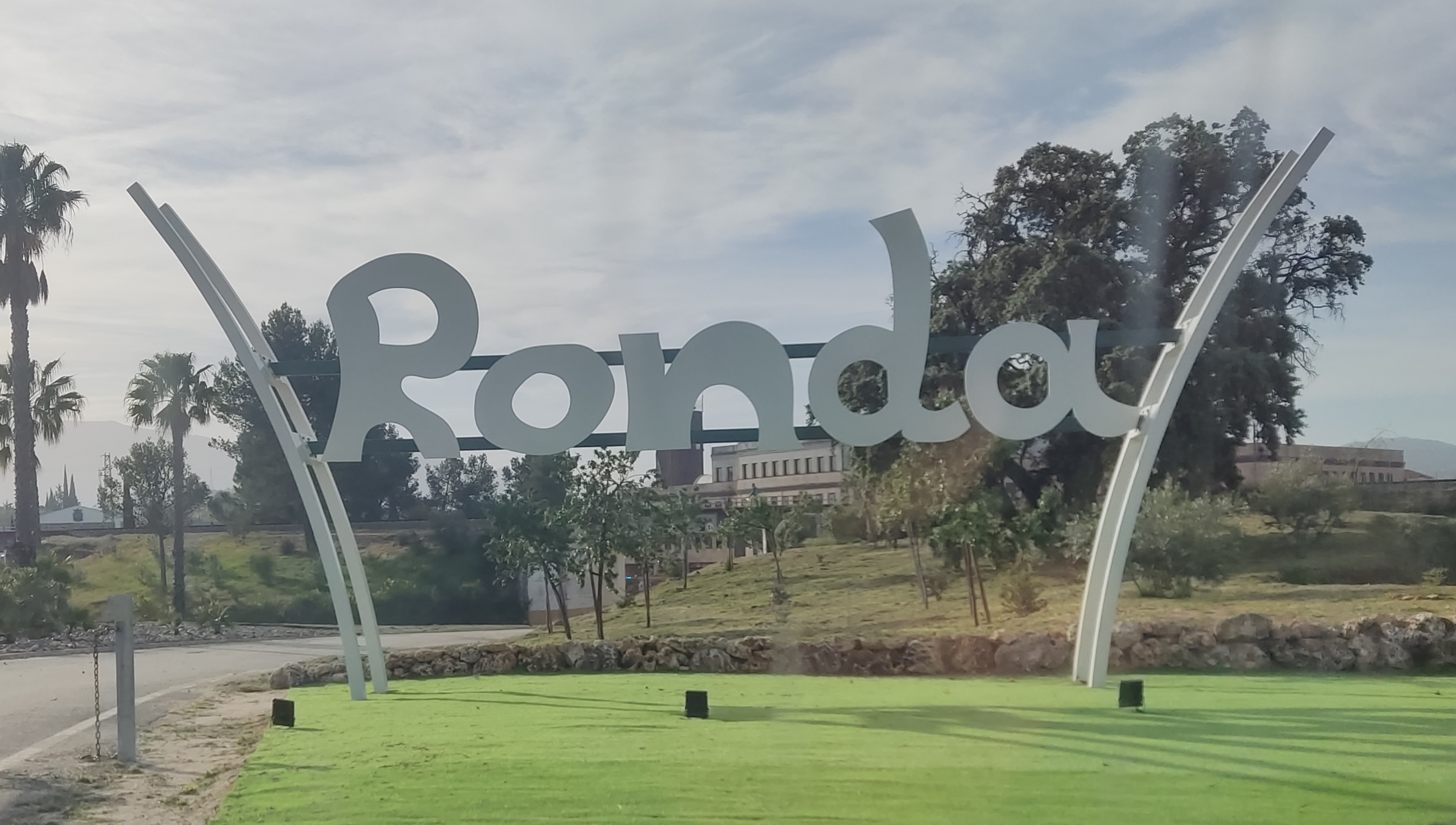 There is a roundabout at nearly every entrance to the town of Ronda (Málaga) – at all points of the compass. Each hosts a symbol or erection of some kind. Within the town itself, they’ve gone in for murals in a big way. The Crazy Guy can think of at least ten. He takes a look. There is a roundabout at nearly every entrance to the town of Ronda (Málaga) – at all points of the compass. Each hosts a symbol or erection of some kind. Within the town itself, they’ve gone in for murals in a big way. The Crazy Guy can think of at least ten. He takes a look.
North by Northwest
Arriving on the A367 Campillos Road you drive past Bar La Fragua, or you stop and call in for coffee or breakfast to see the lovely waitress Nati. Here is also the best car valeting service in town, Lavacar – just 15€, and next door to that is is Viveros Gomez, the garden centre.
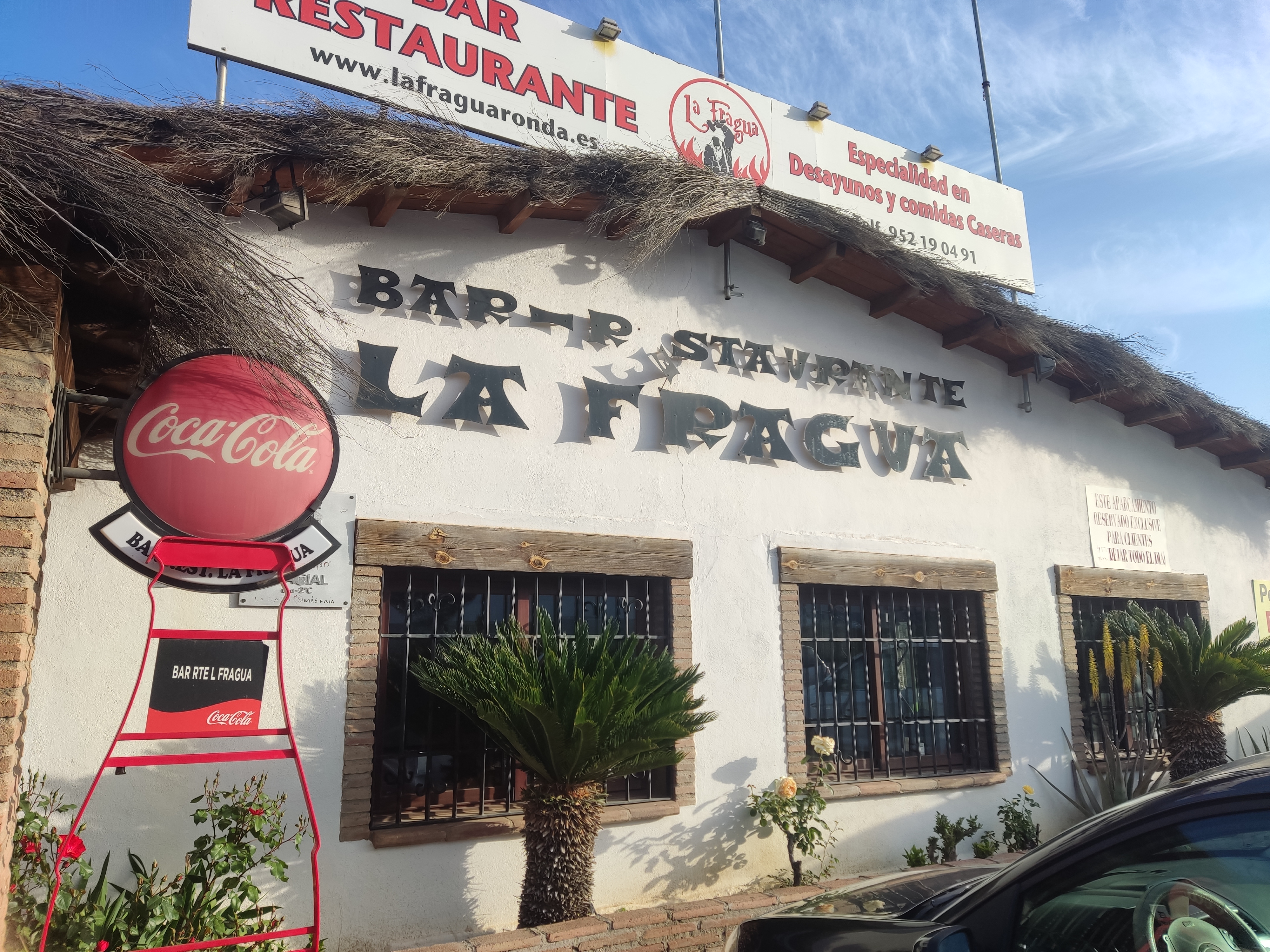 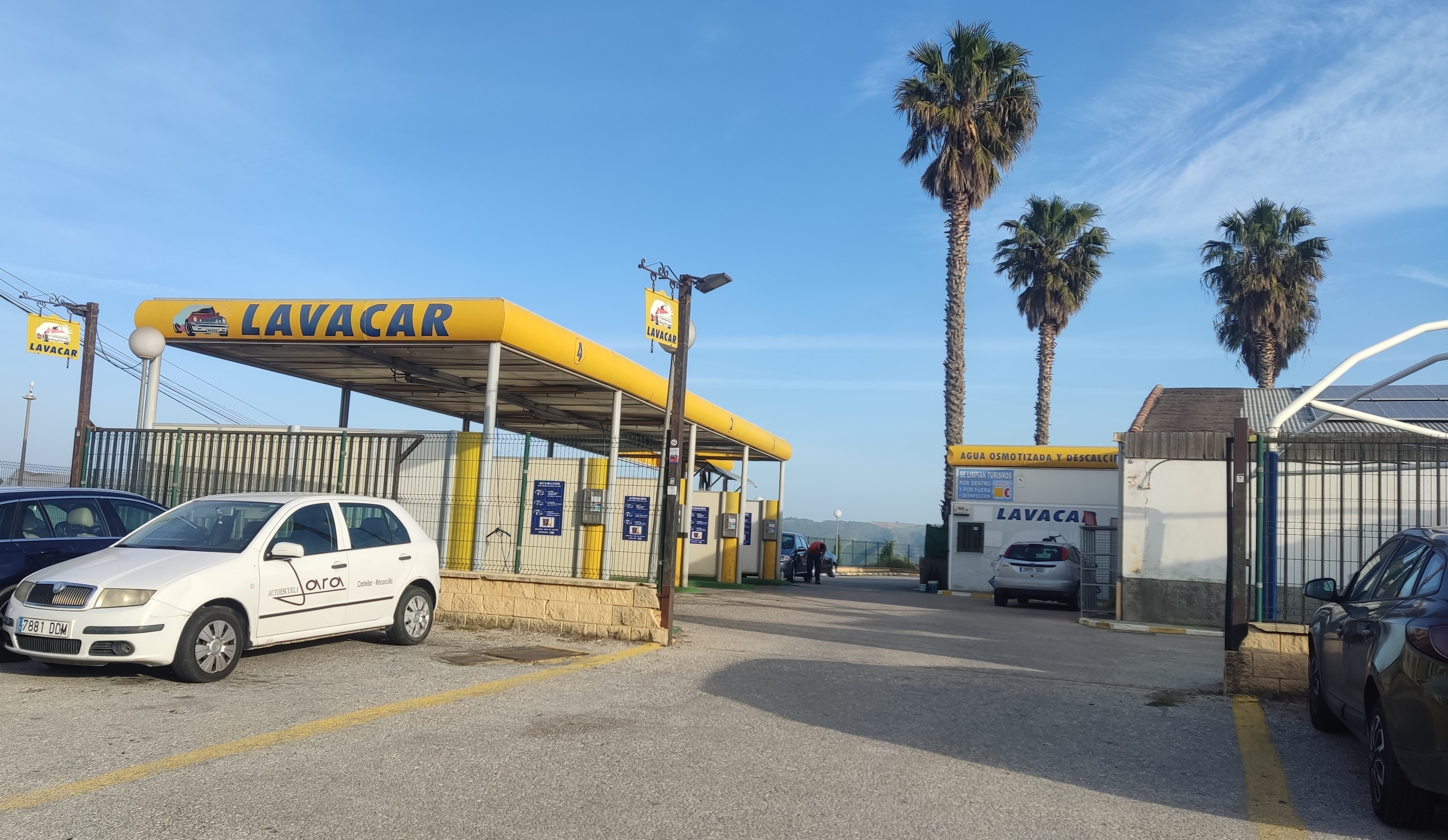 
Next is the biggest roundabout of all located beneath the Algeciras to Bobadilla railway line as it heads into Ronda.
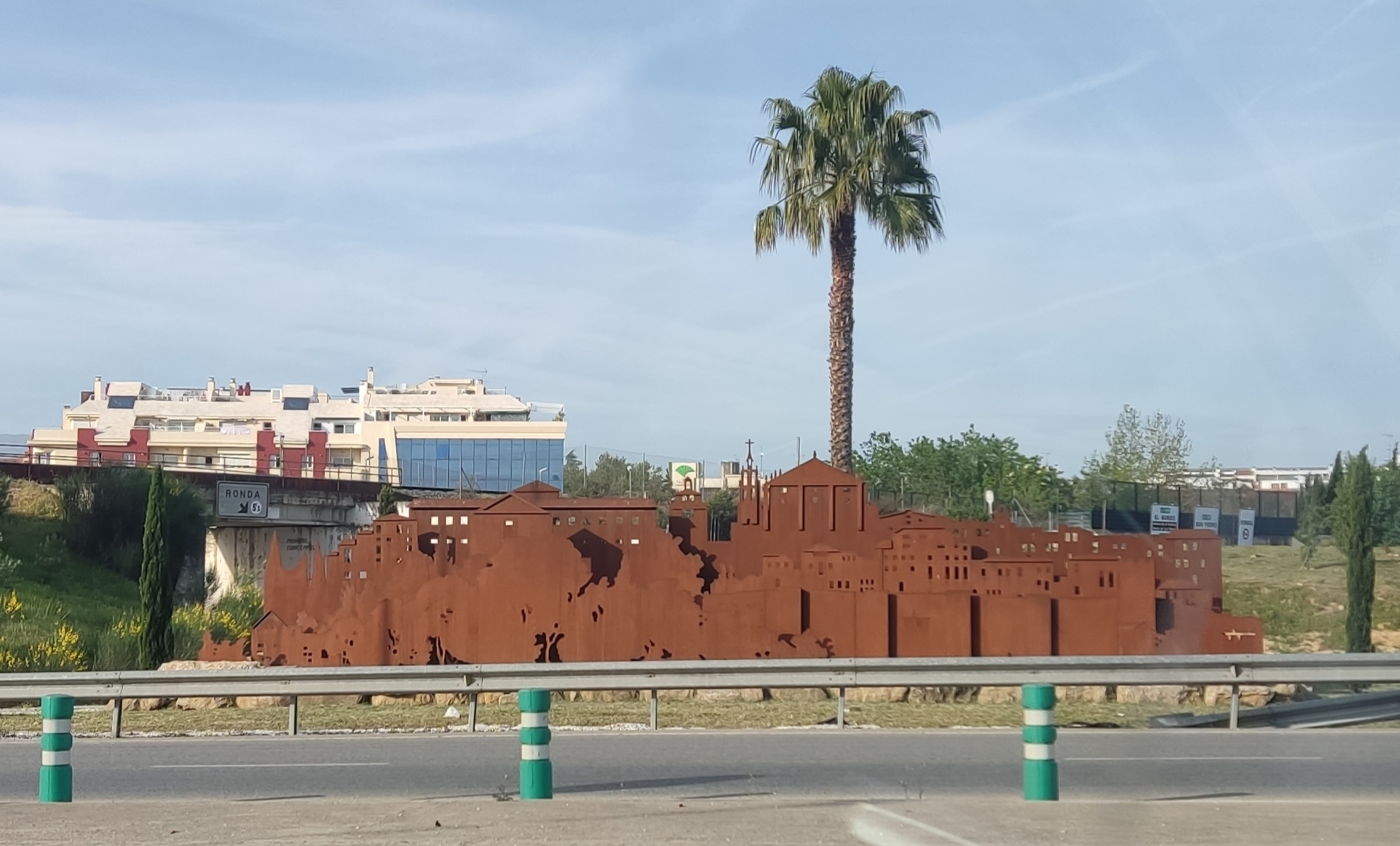 The first thing you see on this roundabout is what looks like a lump of rusty metal. On closer examination you realise it’s a silhouette of a skyline, presumably Ronda. The first thing you see on this roundabout is what looks like a lump of rusty metal. On closer examination you realise it’s a silhouette of a skyline, presumably Ronda.
They go in for rusty stuff around here, by the way, cf. the entrance to the village of El Gastor on the Seville Road.
There is also a big sign welcoming the visitor to Ronda here (see main photo above).
As you h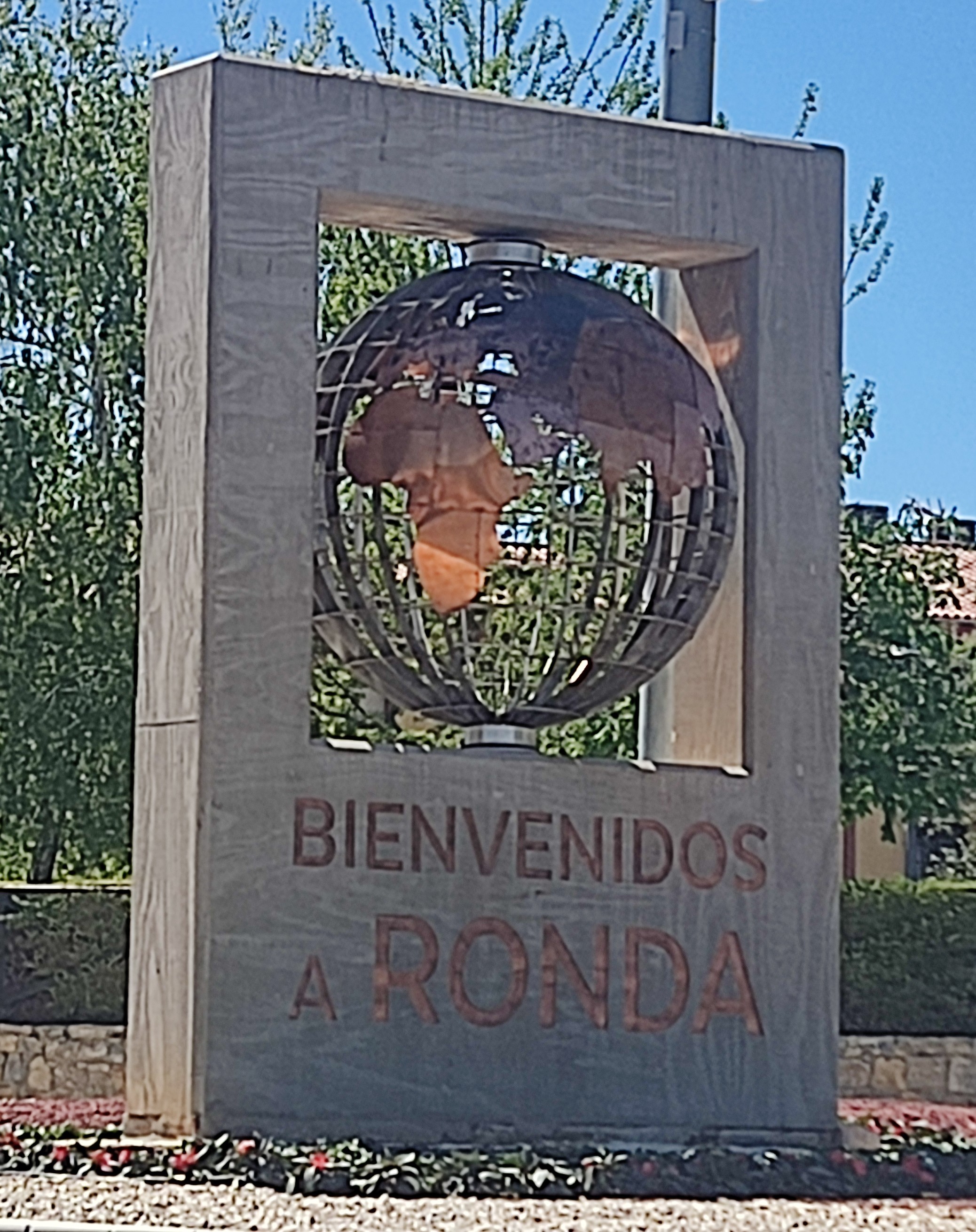 ead onto Avenida de Málaga there is another roundabout, a small one, which hosts a globe of the world and the message Bienvenidos a Ronda. ead onto Avenida de Málaga there is another roundabout, a small one, which hosts a globe of the world and the message Bienvenidos a Ronda.
Avenida de Málaga is a rich source of murals. There are five to the right opposite the CEPSA petrol station (the dearest in town).
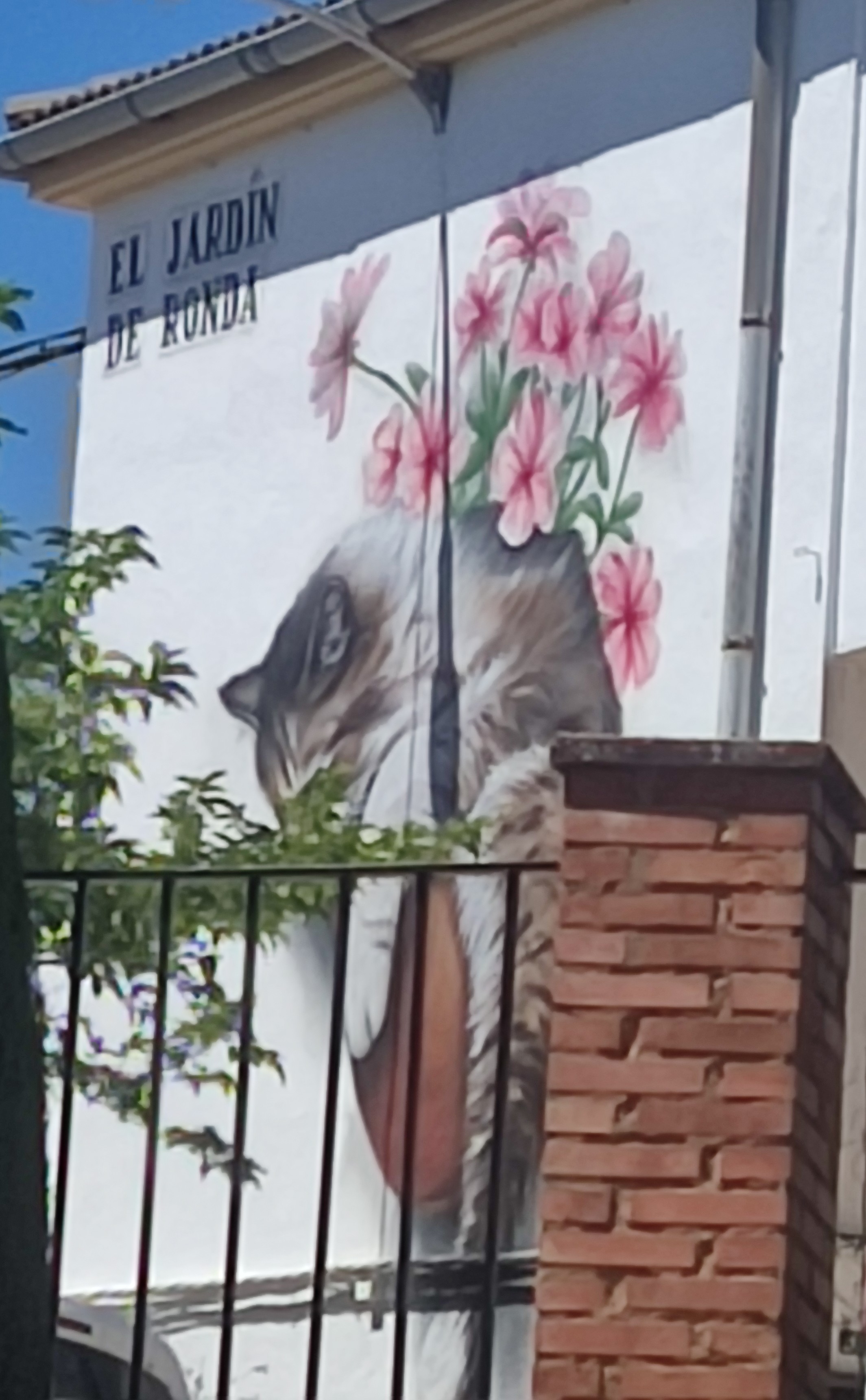 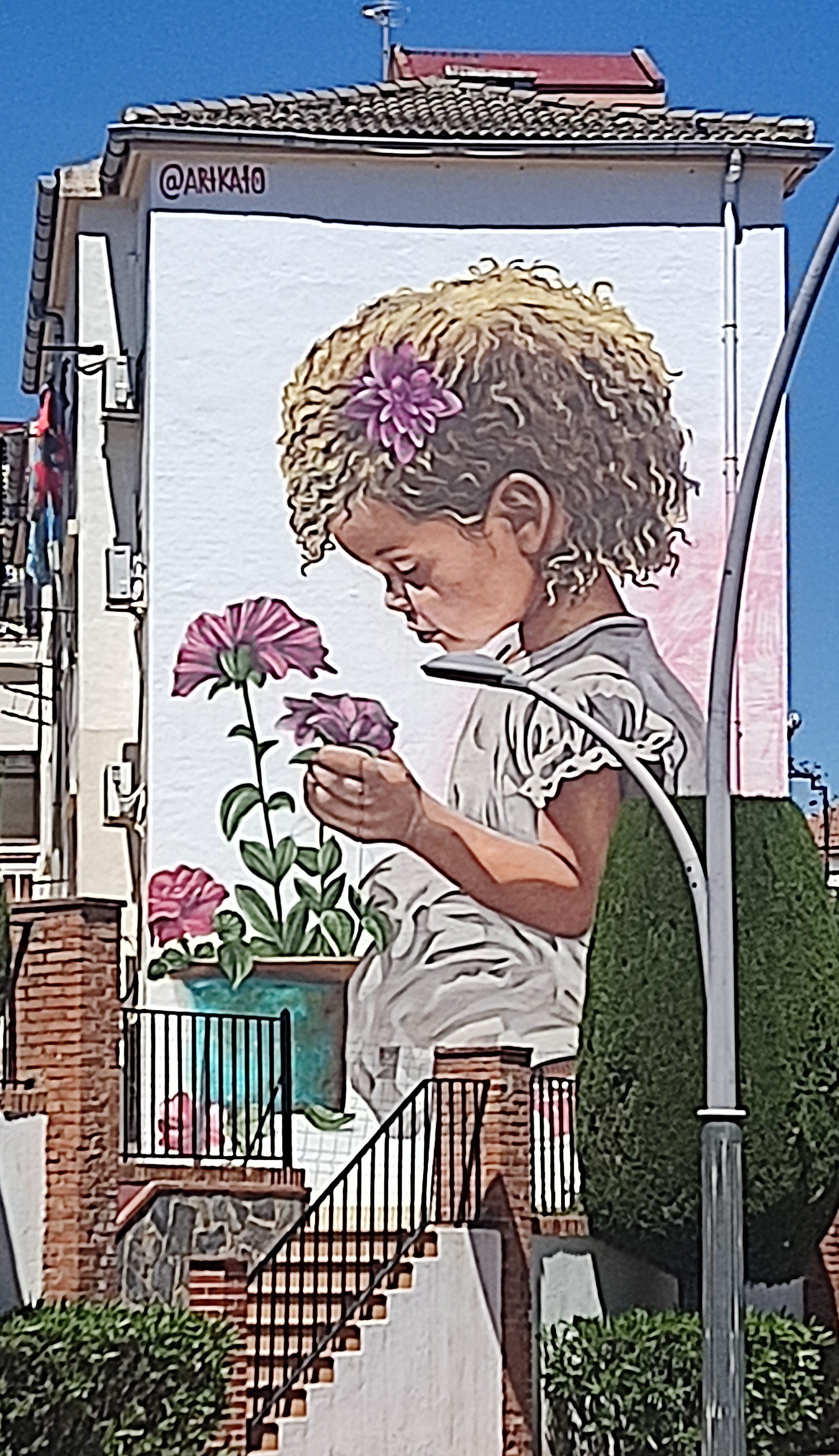 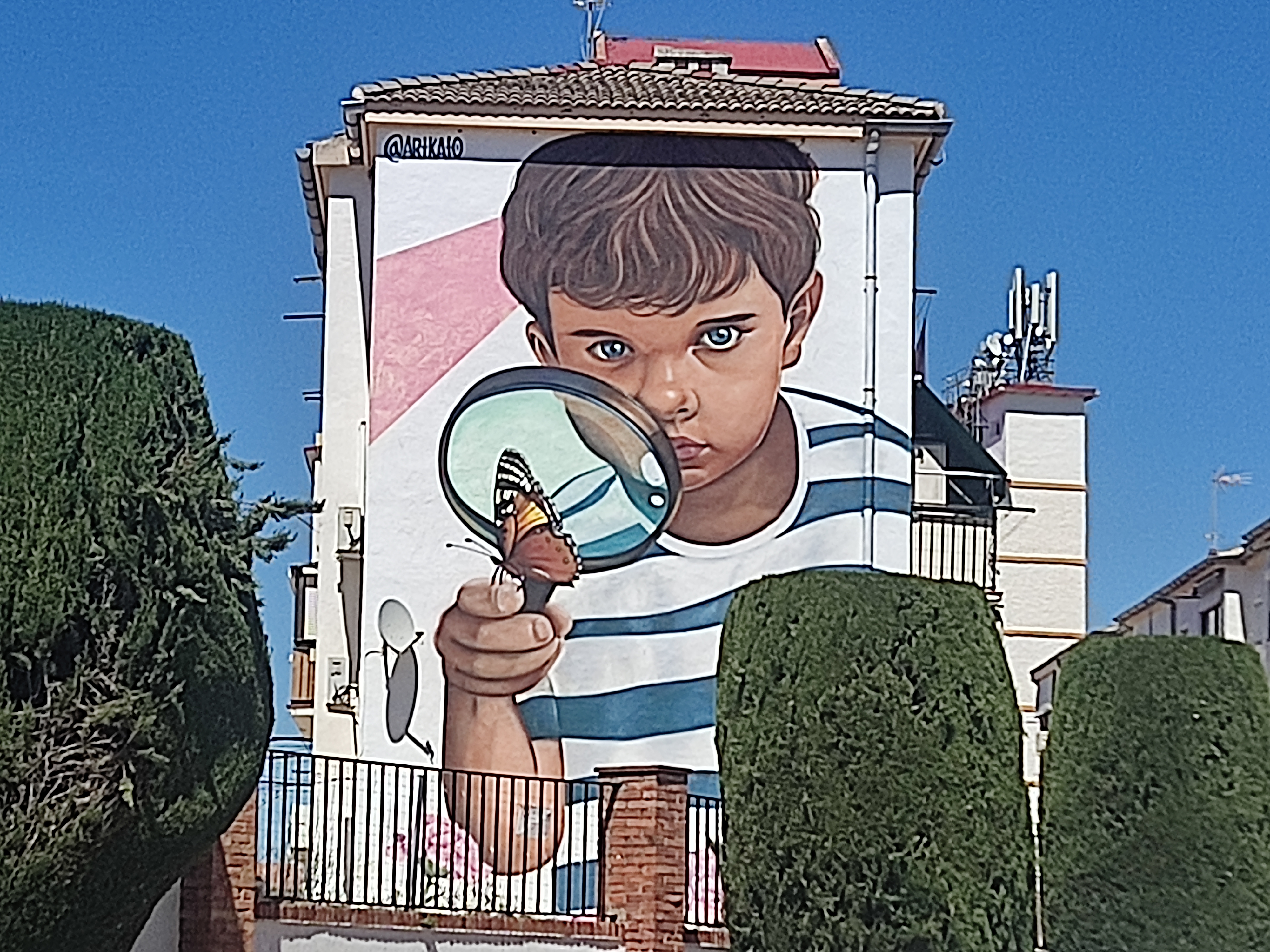
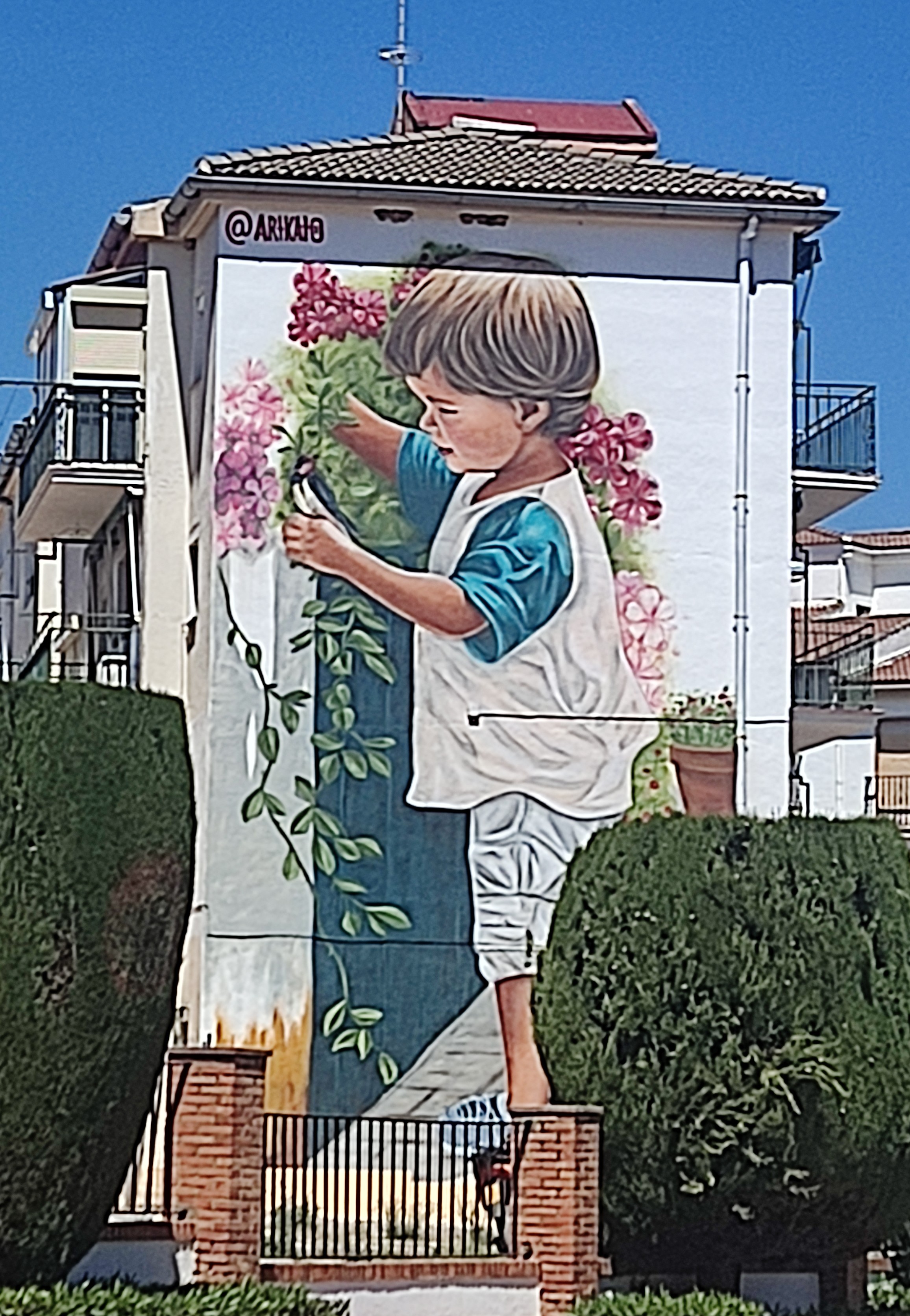 
These are located on the “gable ends” of five blocks of flats and are rather charming. They are by the Basque graffiti artist Arikaio, a kind of Spanish “Banksie”, the celebrated British graffiti dauber.
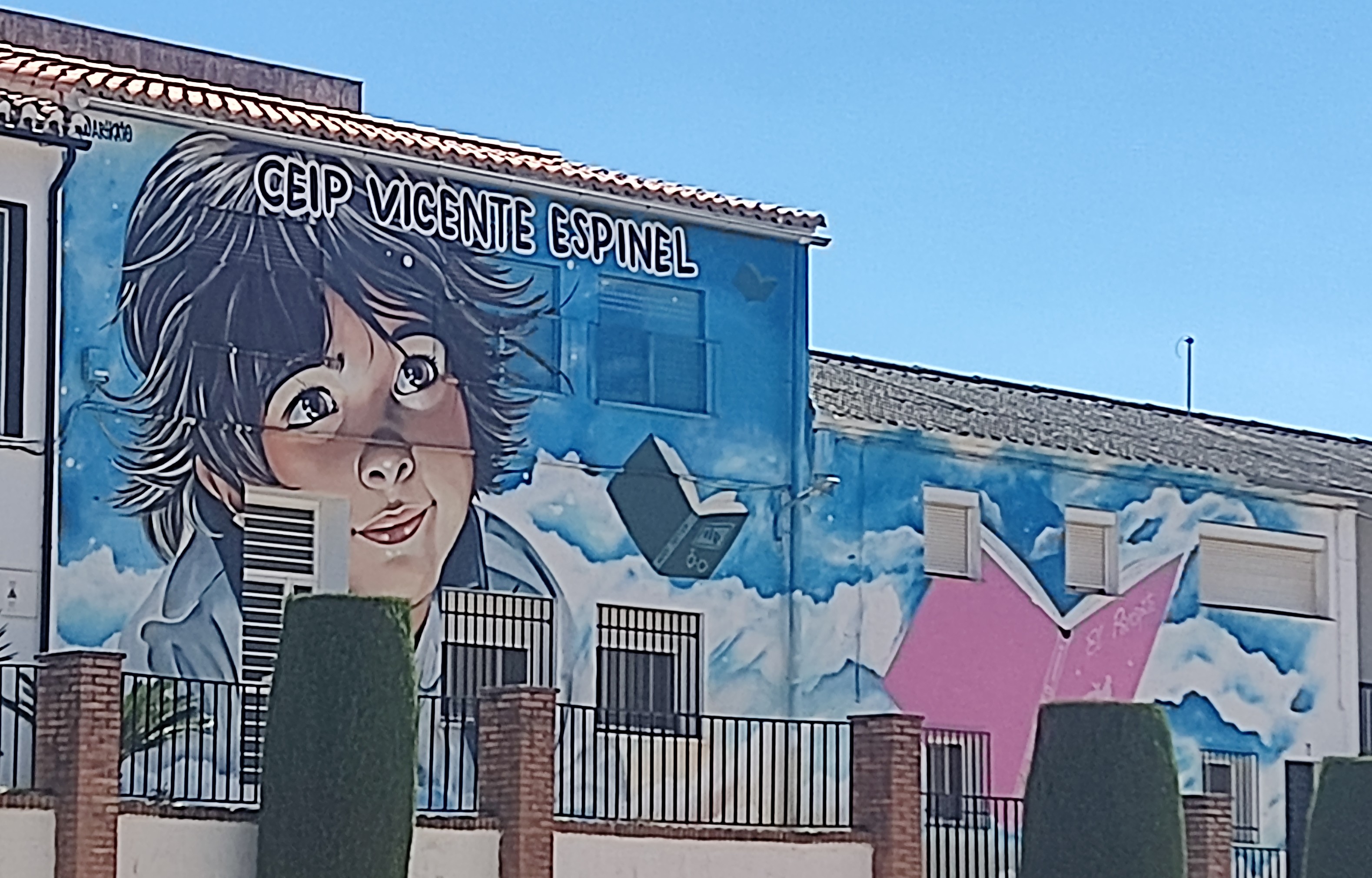
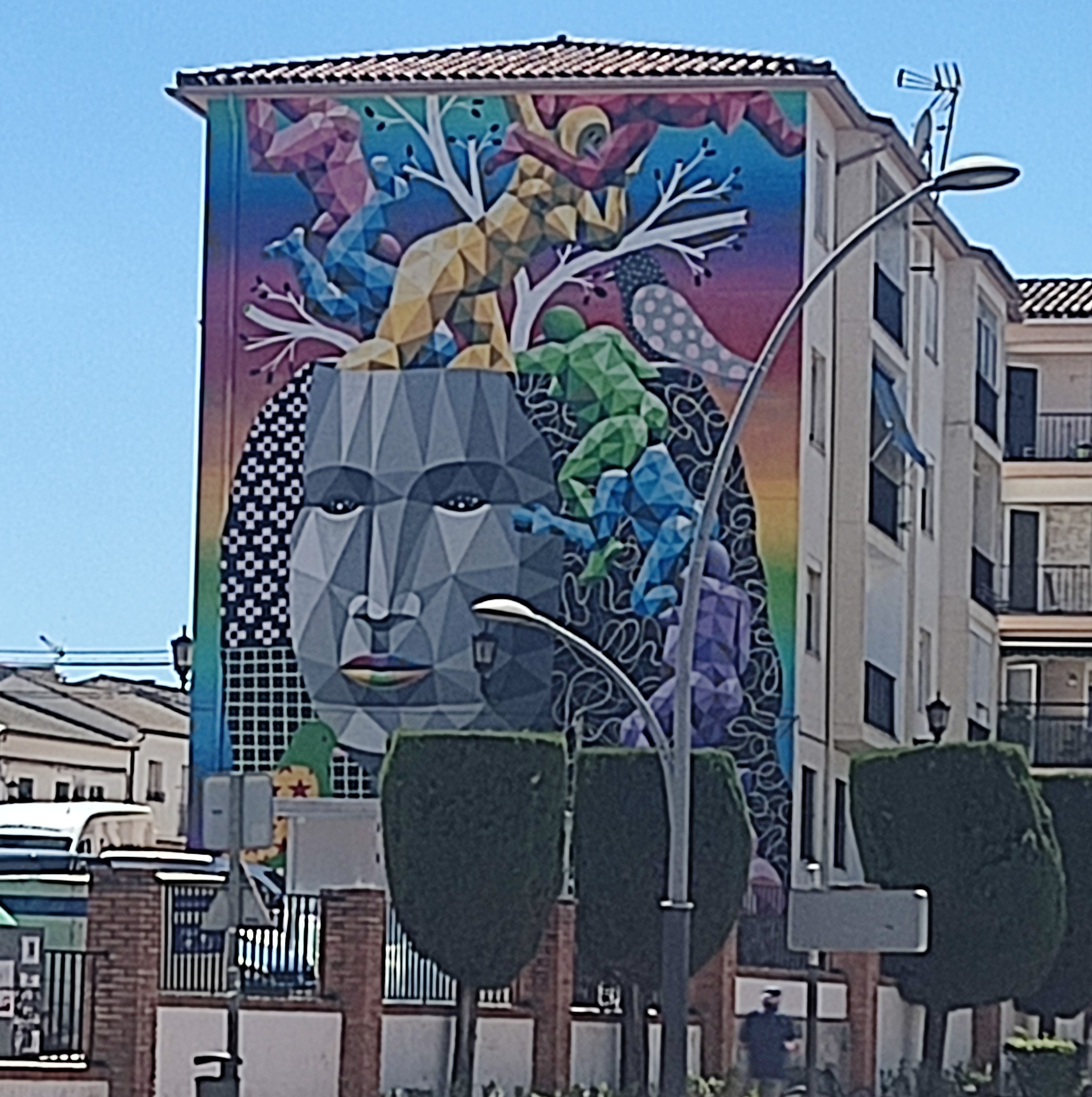
Further on, on the other side of the road, is a splendid rendition on an end wall of a Spanish señorita, the third mural in the town by artist Óscar San Miguel, also known as Okuda.
A bit further on, just past the Guardia Civil Barracks, if you look up to your left there is another mural on a primary school.
Head back to the big roundabout and take the A376 road signposted Sevilla. Almost immediately there is an exit onto the Polígono Industrial, the industrial or trading estate. No roundabout here, so no statue or symbol.
 Back onto the main road and the next entrance into the City of the Tajo is the North West entrance. Here is a roundabout with a sculpture of the Puente Nuevo, the emblematic symbol of Ronda. Back onto the main road and the next entrance into the City of the Tajo is the North West entrance. Here is a roundabout with a sculpture of the Puente Nuevo, the emblematic symbol of Ronda.
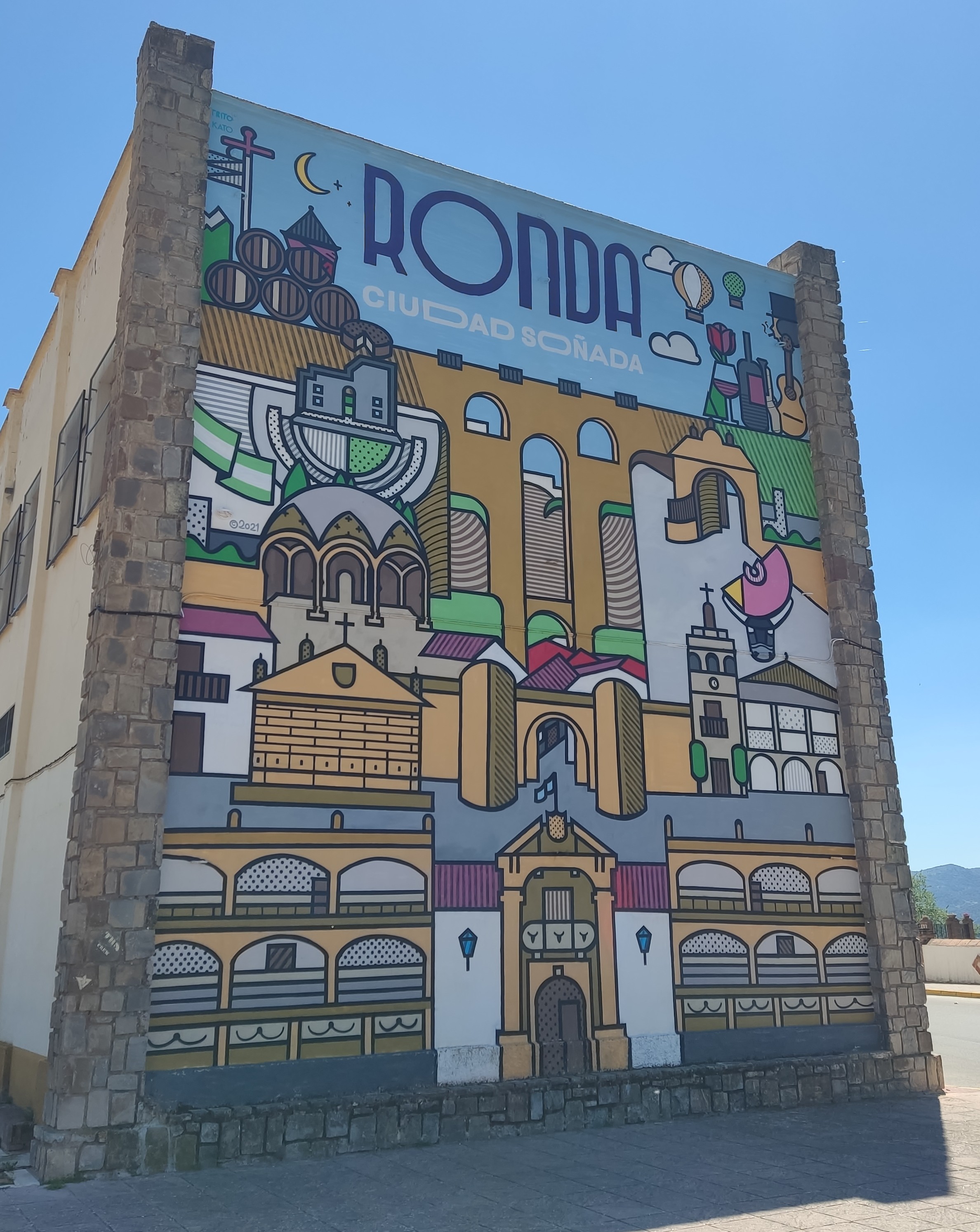 Up into Ronda, past the CEPSA gasolinera, equally as expensive as the afore-mentioned one, and the open-365-days-a-year pharmacy Farmacia Galindo and ahead of you is my favourite of all the murals, a stylised representation of Ronda, featuring all the important landmarks. Fabulous! This was created by rondeño Víctor Fernández. Up into Ronda, past the CEPSA gasolinera, equally as expensive as the afore-mentioned one, and the open-365-days-a-year pharmacy Farmacia Galindo and ahead of you is my favourite of all the murals, a stylised representation of Ronda, featuring all the important landmarks. Fabulous! This was created by rondeño Víctor Fernández.
If you go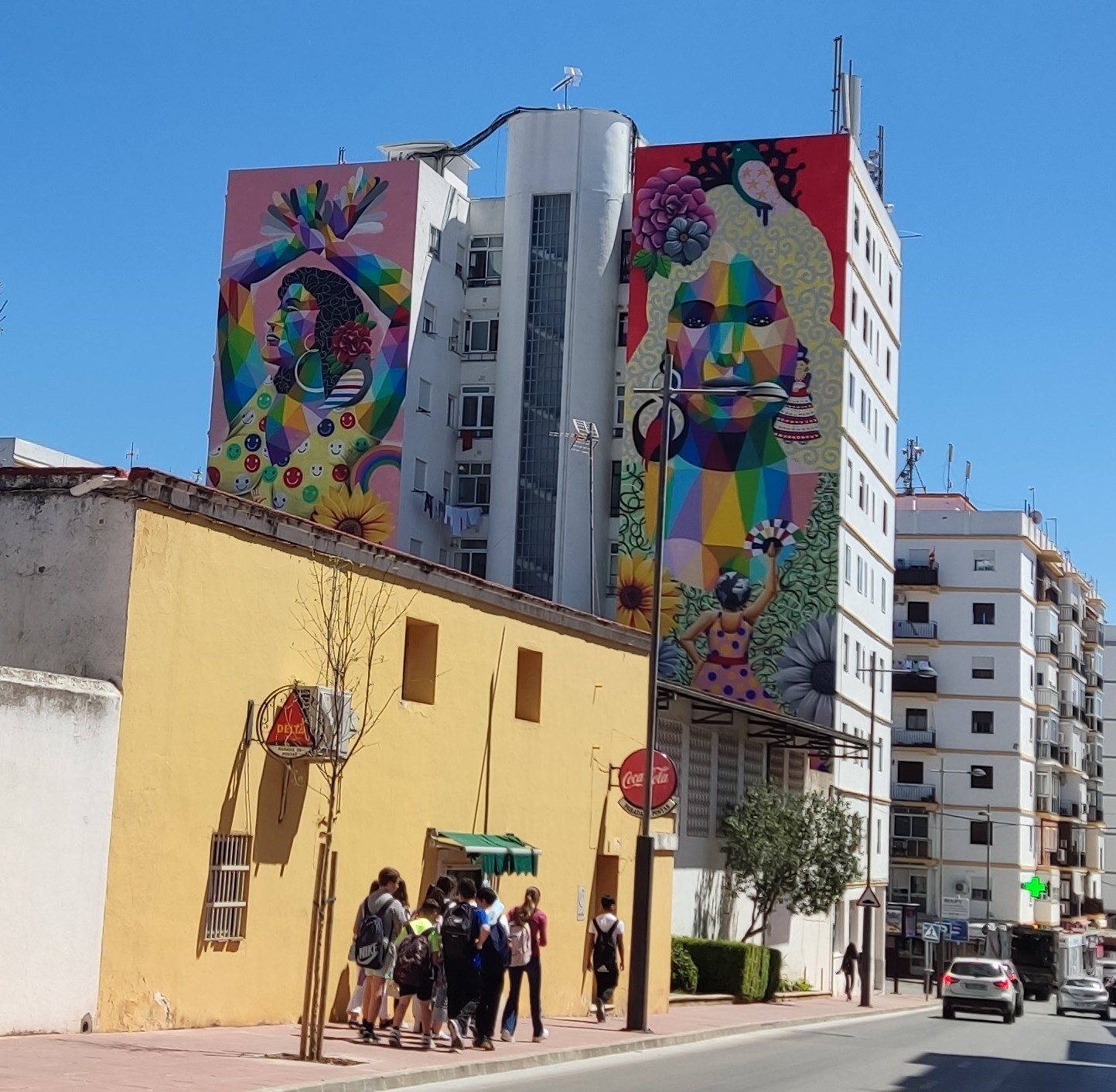 towards the bus station, on the ends of two “skyscrapers” are the first ever murals to grace Ronda. Two ladies in colourful flamenco “gear”. Wonderful! towards the bus station, on the ends of two “skyscrapers” are the first ever murals to grace Ronda. Two ladies in colourful flamenco “gear”. Wonderful!
The artist was Okuda (Óscar San Miguel).
Heading East
Retrace your steps to the big roundabout and head past the Parque de Bomberos, Fire Station, and along the circunvalación, bypass, sign-posted San Pedro de Alcántara 50km. This is the A376.
After 400 metres there is an exit down to the roundabout near LIDL and the white elephant that is the new open-air swimming pool, which is closed for ten months of the year (Rondeños only swim from July to September, coinciding with the schools’ summer vacation).
Here there are two roundabouts in quick succession.
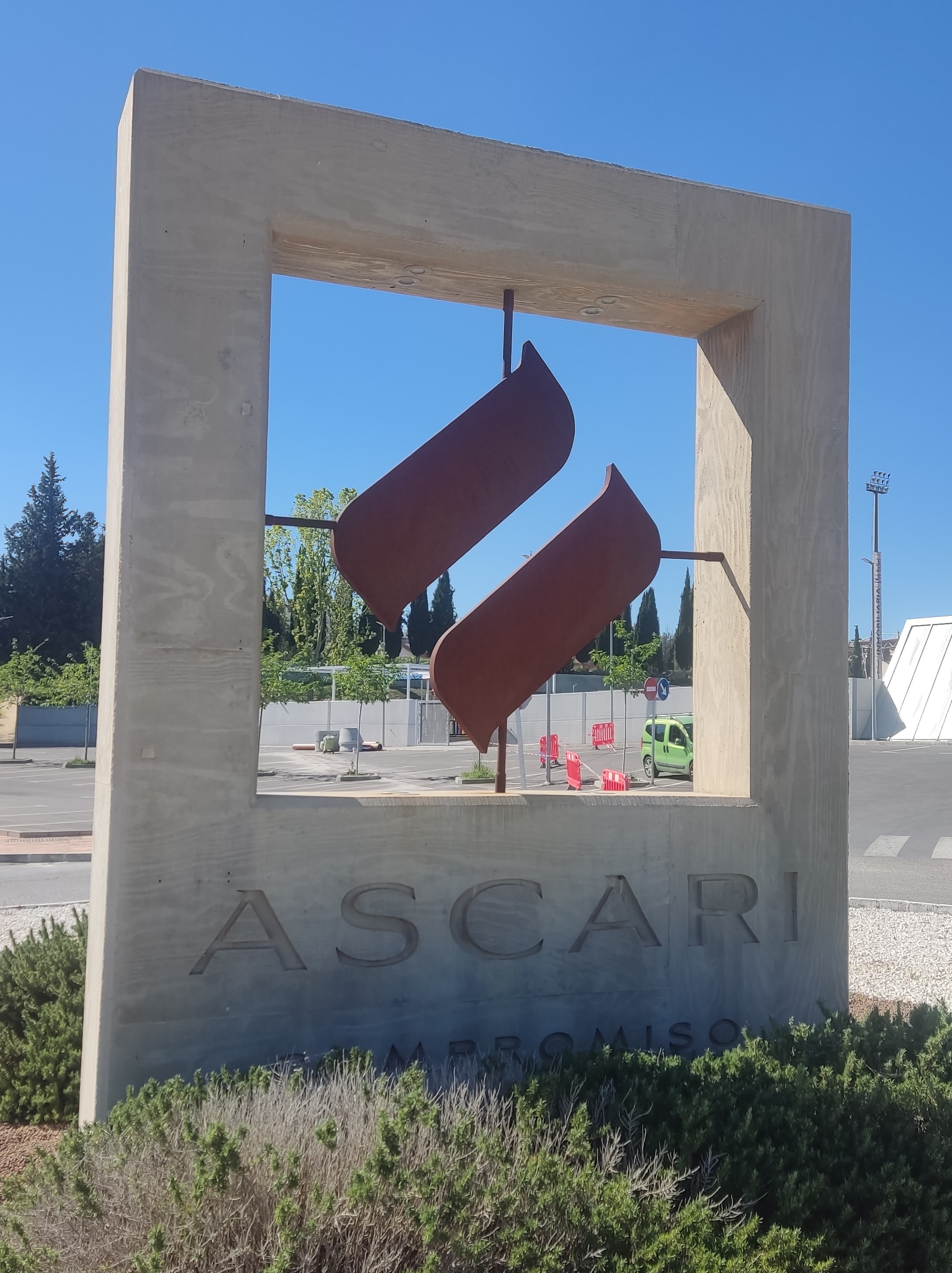 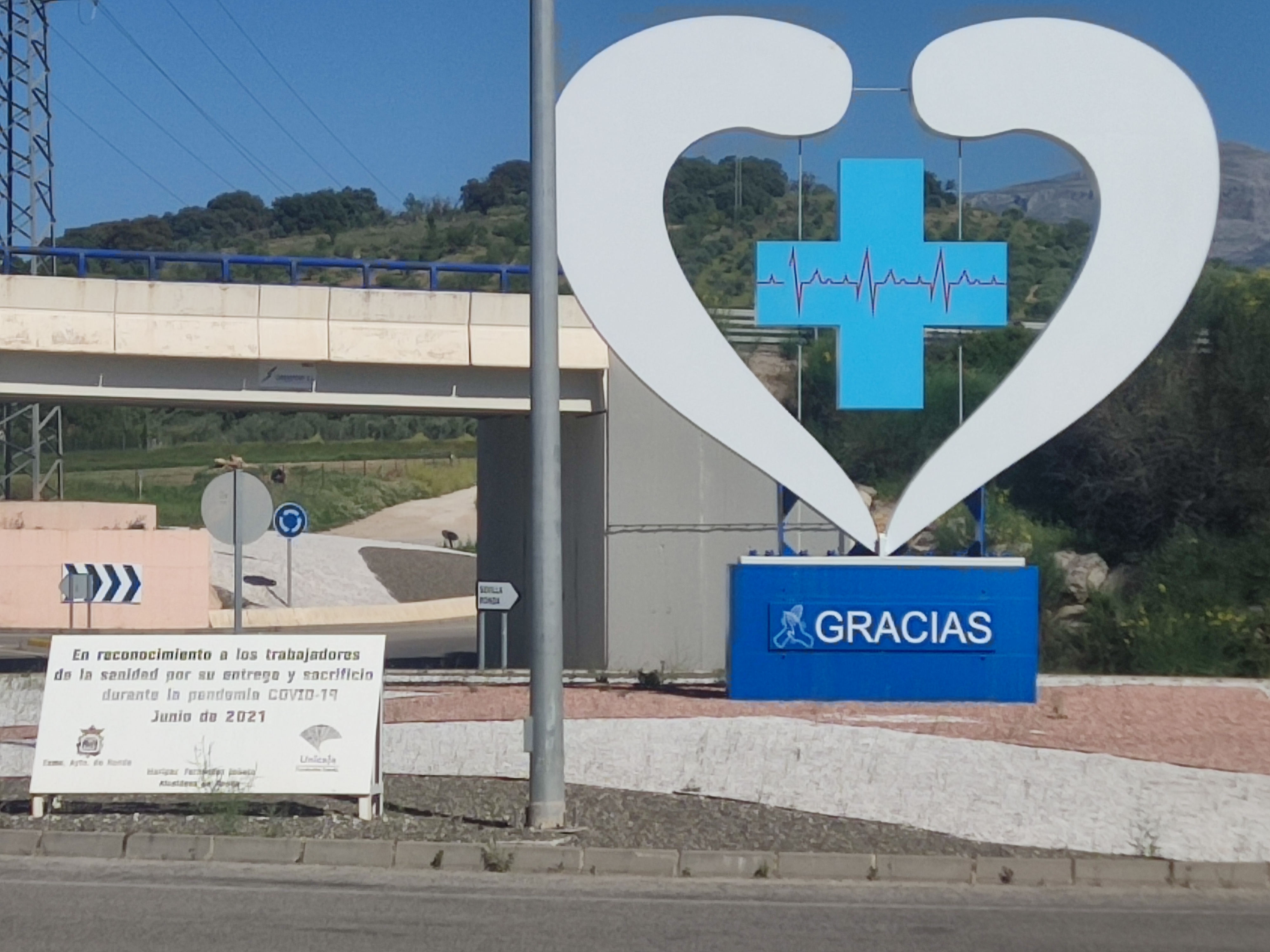 The first has an hommage to those who suffered at the hands of Covid-19, and the second an advertisement for ASCARI, the racetrack on the Campillos Road outside of town. The first has an hommage to those who suffered at the hands of Covid-19, and the second an advertisement for ASCARI, the racetrack on the Campillos Road outside of town.
Strangely, this is dedicated to disgraced Ronda mayor, now deceased, Antonio María Marín Lara, nicknamed Toti. He was found guilty of corruption on a massive scale while in office, yet escaped gaol time.
Well, he was a lawyer. Enough said?
Down South
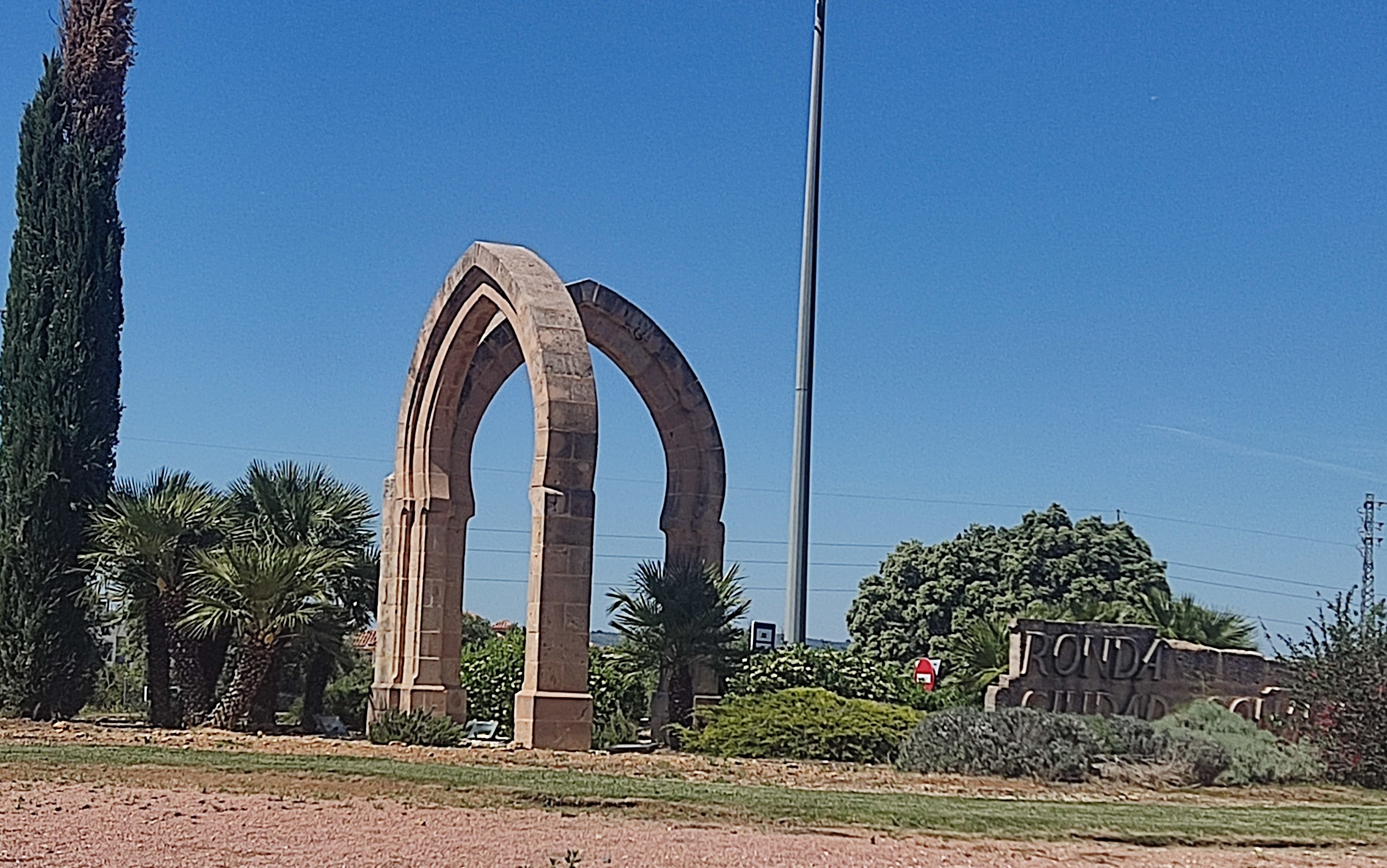 Back on to the A376 heading south, take the exit for Ronda South. On this roundabout stand two Moorish arches and the words Ronda Ciudad Soñada (a reference to Austrian poet Rainer Maria Rilke who lived in Ronda for a time and coined the phrase. Back on to the A376 heading south, take the exit for Ronda South. On this roundabout stand two Moorish arches and the words Ronda Ciudad Soñada (a reference to Austrian poet Rainer Maria Rilke who lived in Ronda for a time and coined the phrase.
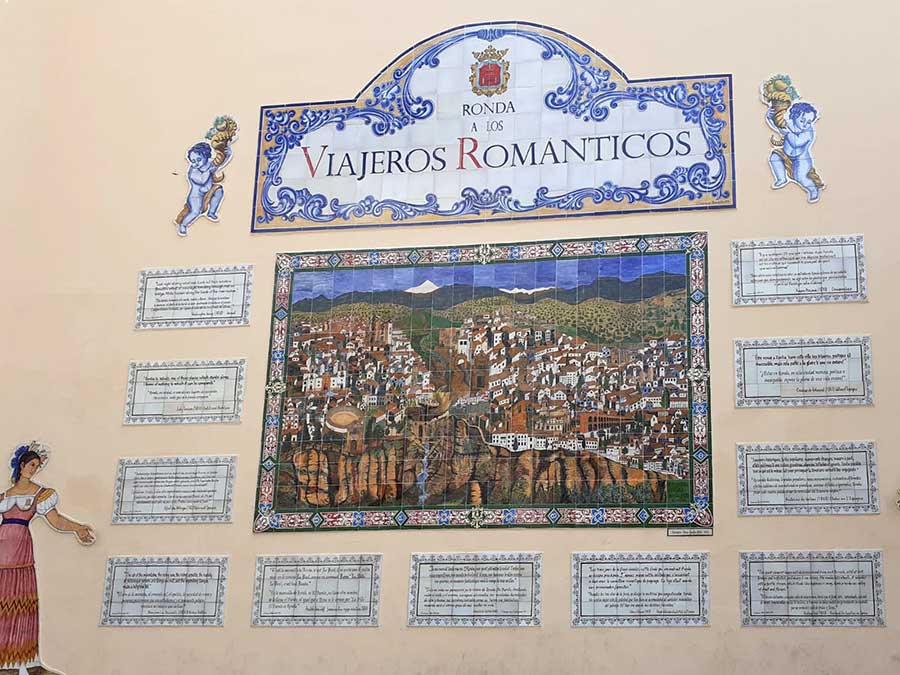 If you keep going into town, at the southern end of the Puente Nuevo opposite Calle Tenorio is a tiled mural that has been around for a few years. A tribute to the Viajeros Románticos (Romantic Travellers), it is a stylised aerial view of Ronda. If you keep going into town, at the southern end of the Puente Nuevo opposite Calle Tenorio is a tiled mural that has been around for a few years. A tribute to the Viajeros Románticos (Romantic Travellers), it is a stylised aerial view of Ronda.
There are quotations from some of these XIX century travellers and writers, including Bécquer, Ford, Irving and Mérimée.
Epilogue
That's it folks! Ronda roundabouts and murals. Although I am The Crazy Guy, I must confess that both the roundabouts and especially the murals enhance the urban landscape of the Ciudad Soñada.
All photographs by Paul Whitelock
© The Crazy Guy
Links:
HELP ME RONDA (eyeonspain.com)
How did Ronda get the name "City of Dreams"? - Help me, Ronda (help-me-ronda.com)
‘St Michael’ comes to Ronda - Secret Serrania de Ronda
Un año sin Antonio María Marín Lara (Toti) | Diario Ronda
Tags:
A367, A376, Antonio Marin Lara, Arikaio, Ascari, Avenida de Malaga, Banksie, Basque, Bienvenidos a Ronda, Campillos, CEPSA, City of the Tajo, Ciudad Soñada, Covid-19, Crazy Guy, Diario Ronda, Farmacia Galindo, globe, grafitti, El Burgo, Help Me Ronda, La Fragua, Moorish arches, mural, Óscar San Miguel, Okuda, Paul Whitelock, Puente Nuevo, Rainer Maria Rilke, Rilke, Romantic Travellers, Ronda, rondeño, roundabout, San Pedro de Alcántara, Secret Serrania, Sevilla, Toti, Viajeros Románticos, Víctor Fernández, Viveros Gomez, www.eyeonspain.com, www.help-me-ronda.com
 1
Like
Published at 7:43 AM Comments (2)
1
Like
Published at 7:43 AM Comments (2)
Andalusien ist schön
Sunday, March 31, 2024
Five of the 10 "most beautiful" provincial capitals in Spain are located in Andalusia, including the first place.
ElectoPanel surveyed 4,000 Spaniards to find out where they see the most beautiful places in the country.
The crown jewel is Seville, which took first place with 14.4% of the votes from people impressed by the mix of Moorish and Gothic architecture, as well as the cultural and gastronomic history.
Granada, with the emblematic Alhambra, the winding streets of the Albaicin and the breathtaking views of the Sierra Nevada, received 13.9% of the vote, securing second place.
With 4.5% of the vote, Cádiz came in sixth, closely followed by Córdoba in seventh place.
And Málaga came in ninth place with 3.6% of the vote.
Fünf der 10 “schönsten” Provinzhauptstädte Spaniens liegen in Andalusien, darunter der erste Platz.
ElectoPanel hat 4.000 Spanier befragt, um herauszufinden, wo sie die schönsten Orte des Landes sehen.
Das Kronjuwel ist Sevilla, das mit 14,4 % der Stimmen von Menschen, die von der Mischung aus maurischer und gotischer Architektur sowie von der kulturellen und gastronomischen Geschichte beeindruckt sind, den ersten Platz belegte.
Granada mit der symbolträchtigen Alhambra, den verwinkelten Gassen des Albaicin und der atemberaubenden Aussicht auf die Sierra Nevada erhielt 13,9 % der Stimmen und sicherte sich damit den zweiten Platz.
Mit 4,5 % der Stimmen kam Cádiz auf den sechsten Platz, dicht gefolgt von Córdoba auf dem siebten Platz.
Und Málaga kam mit 3,6 % der Stimmen auf den neunten Platz.
 0
Like
Published at 6:18 PM Comments (0)
0
Like
Published at 6:18 PM Comments (0)
CAR LITERACY
Sunday, March 3, 2024
 By The Crazy Guy By The Crazy Guy
The letters which appear on our vehicle registrations are fascinating. The ones listed below all have a significance for The Crazy Guy. Let’s take a look!
Provincial Codes – AL, B, CA, CO, GR, H, J, M, MA, SE and SS
From 1900 until 2000, normal car registrations began with the province code where the vehicle was first registered. These cars retained the same number for life, as in the UK, but not in Germany, where change of ownership requires a new registration plate.
That is why we still see older vehicles with the provincial code, viz. Almería, Barcelona, Cádiz, Córdoba, Granada, Huelva, Jaén, Madrid, Málaga, Sevilla and San Sebastián. I chose these because I’ve been to them all and they have personal meanings for me:
Barcelona, the capital of Cataluña, I used to visit quite frequently years ago, for work and for pleasure. The city of Las Ramblas, Gaudi, Parque Guell and Barca is fascinating.
 Madrid, the capital, I’ve been to with work and for pleasure. De Madrid al Cielo, as they say. Plaza Mayor, Parque del Retiro, Museo del Prado and Real Madrid and Atlético Madrid. Fabulous! Madrid, the capital, I’ve been to with work and for pleasure. De Madrid al Cielo, as they say. Plaza Mayor, Parque del Retiro, Museo del Prado and Real Madrid and Atlético Madrid. Fabulous!
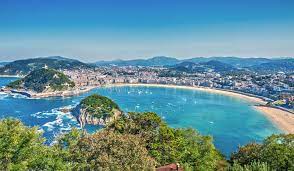 San Sebastián (or Donostia), capital of the Basque province of Gipuzkoa, is where I spent my formative years as a student of Spanish. Playa de la Concha, La Parte Vieja, Monte Igueldo and Real Sociedad FC. The jewel in the crown. San Sebastián (or Donostia), capital of the Basque province of Gipuzkoa, is where I spent my formative years as a student of Spanish. Playa de la Concha, La Parte Vieja, Monte Igueldo and Real Sociedad FC. The jewel in the crown.
***
Cádiz, Córdoba, Granada, Málaga and Sevilla are neighbouring provinces in Andalucia. I love all five capitals. Each different.
Cádiz has its long coastline, the Cámara Oscura and great food and drink (including Spanish real ale!).
Córdoba boasts the Mezquita and its Jewish Quarter.
Granada has the Alhambra and the Sacromonte.
Málaga has Mount Gibralfaro, its Roman Theatre, the refurbished Port Area and Picasso.
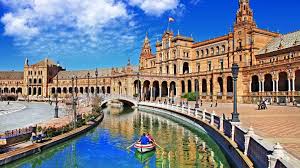
Sevilla is just ….. Sevilla: La Catedral, La Giralda, La Torre del Oro, Plaza de España, Casco Antiguo, and two Primera Liga football clubs, Real Betis and FC Sevilla.
Almería, Huelva, Jaén, the remaining provinces of Andalucía, are places I visited in the past. Great beaches (not in Jaén, obviously!). Almería also has the spaghetti western film set in the desert; Huelva, the estuary of the River Guadalquivir; and Jaén has Úbeda and Baeza, fabulous towns, steeped in history.
Official vehicles – CME, CNP, EA, ET, PGC
CME is Cos dels Mossos d'Esquadra, the Catalán equivalent of the Policía Nacional.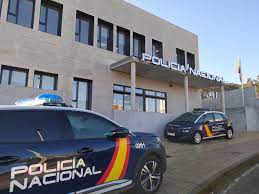
CNP is the Cuerpo Nacional de Policía, or Policía Nacional, the national force responsible mainly for crime.
EA is the Spanish Airforce – Ejército del Aire.
ET is the Spanish Army – Ejército de Tierra.
PGC is the Policía Guardia Civil.
Personal vehicles – DSW, ENJ, GHC, GPM, KBF, KVV, LSL, PJW
2099 DSW was my first Spanish car, a SEAT Leon. What a great car that was! I only sold it because I bought a VW Transporter van, so didn’t need the car any longer.
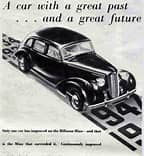 ENJ 406 was our first car when I was growing up in Devon in the 1950s. It was a Hillman Minx saloon with split windscreen and running boards. It had apparently been an army staff car in the Second World War. My dad shelled out ….. a massive 125 pounds for it! ENJ 406 was our first car when I was growing up in Devon in the 1950s. It was a Hillman Minx saloon with split windscreen and running boards. It had apparently been an army staff car in the Second World War. My dad shelled out ….. a massive 125 pounds for it!
5435 GHC was Rita’s Peugeot 206 cabriolet which she bought new in Germany and imported to Spain when she emigrated here in 2006. Sadly, the engine caught fire in 2021 and the car had to be scrapped.
7621 GPM was Rita’s replacement car, a Peugeot 207 cabriolet, which we bought in Madrid.
YB54 KBF is the Volkswagen Transporter T20 van I bought from my neighbour, JM, who some months later in a fit of spite, set it alight and wrote it off (allegedly). The police know he did it, but there was no proof.
8130 KVV is my current car, a Peugeot 2008.
1142 LSL is the number I was allocated when I legalised the VW Transporter by officially importing it and re-registering it here in Spain.
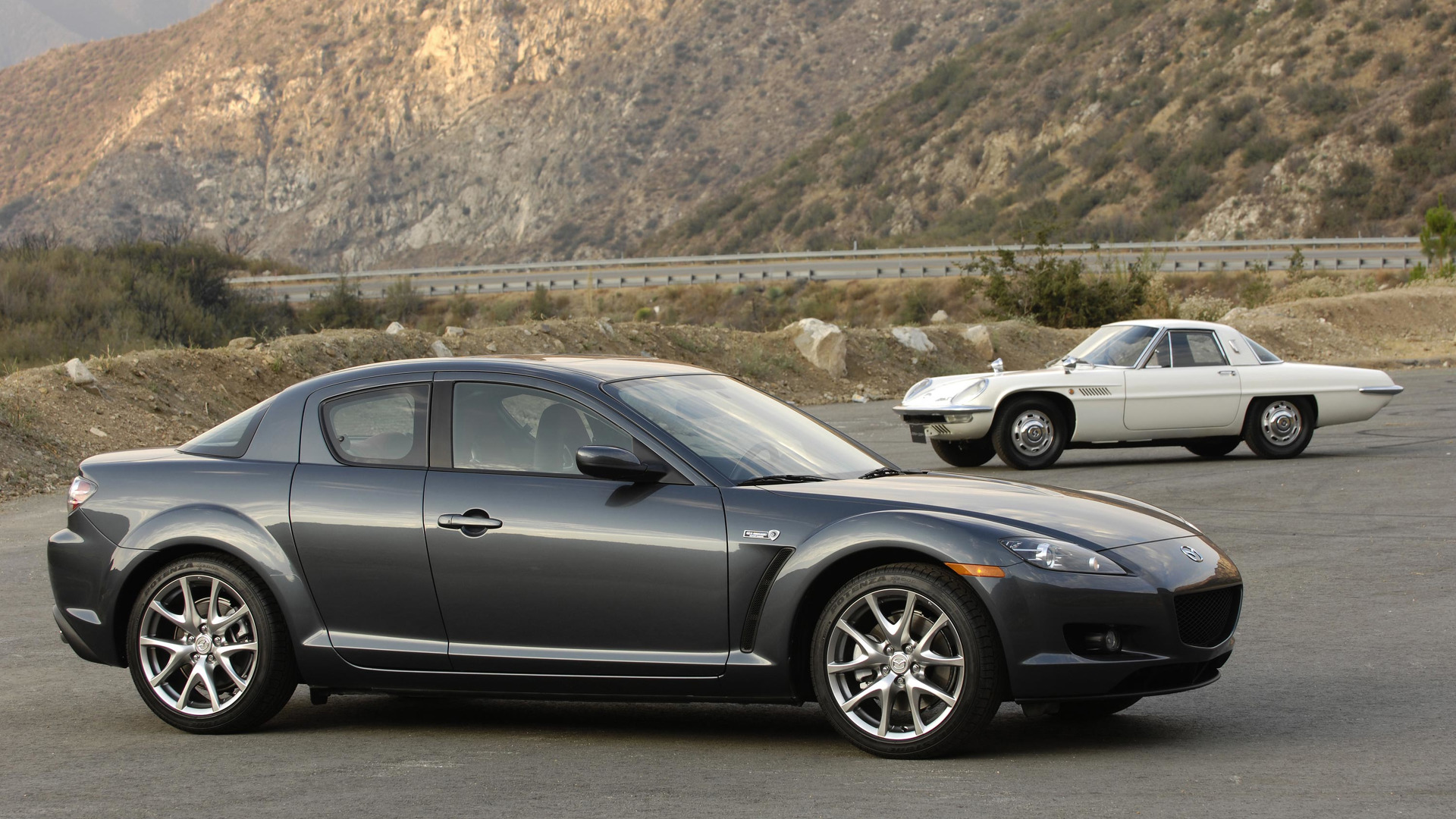 M50 PJW is the personalised registration (cherished number plate) to which I treated myself when I reached 50 years of age and bought a Mazda RX8, the best car I ever had. M50 PJW is the personalised registration (cherished number plate) to which I treated myself when I reached 50 years of age and bought a Mazda RX8, the best car I ever had.
This was a sports car with a Wankel rotary engine. I loved my “male menopause” purchase. When I got through said “menopause, I sold the Mazda and a bought a somewhat boring Ford Focus onto which my cherished number was transferred.
I sold the Focus when I bought a Vauxhall Vivaro van, which I needed while doing up my house in England and when I emigrated to Spain. I sold the Vivaro van to my German pal Rainer, who made me a good offer. He exported it to Germany, where he and his missus Iris, used it for many years. Sadly, I hear it is no longer going strong!
Note: I can’t include the reg. no. of the Vivaro, simply because I can’t remember it and no longer have any paperwork.
Conclusion
So, there we have it. The vehicle registration letters that have been important in my life, from Spanish provincial markers, through official Spanish vehicles to my privately-owned cars and vans, both in the UK and in Spain.
© The Crazy Guy
Acknowledgements:
civitatis
guardia civil
jdpower.com
Paul Whitelock
Tags:
Almería, Alhambra, Andalucia, army staff car, Atlético, Barca, Barcelona, Basque, cabriolet, Cádiz, Cámara Oscura, car registration, Casco Antiguo, Cataluña, Catedral, cherished number, Córdoba, Cos dels Mossos d'Esquadra, CME, CNP, Cuerpo Nacional de Policía, De Madrid al Cielo, Donostia, EA, ejército del Aire, ejército de Tierra, ET, FC Sevilla, Ford Focus, Gaudi, Gibralfaro, Gipuzkoa, Giralda, Granada, Guadalquivir, Guardia Civil, Hillman Minx, Huelva, Jaén, La Parte Vieja, Las Ramblas, Madrid, Málaga, male menopause, Mazda RX8, Mezquita, Monte Igueldo, Museo del Prado, Parque del Retiro, Parque Guell, Parte Vieja, Paul Whitelock, personalised registration, Peugeot 2008, Peugeot 206, Peugeot 207, PGC, Picasso, Playa de la Concha, Plaza de España, Plaza Mayor, Policía Nacional, Primera Liga, province code, Real Betis, Real Madrid, Real Sociedad FC, registration, rgistration plate, Roman Theatre, running boards, Sacromonte, San Sebastián, SEAT Leon, Second World War. Sevilla, spaghetti western, split windscreen, Torre del Oro, Úbeda, Vauxhall Vivaro, Volkswagen Transporter T20, VW Transporter, Wankel rotary engine.
 3
Like
Published at 10:55 AM Comments (1)
3
Like
Published at 10:55 AM Comments (1)
10,000 steps a day? Rubbish!
Thursday, January 18, 2024
By The Crazy Guy
 In order to keep fit and healthy and to prolong our lives, we are supposed to take 10,000 steps a day, say medical experts. “Rubbish!” says The Crazy Guy, not one to blindly accept everything we are told. In order to keep fit and healthy and to prolong our lives, we are supposed to take 10,000 steps a day, say medical experts. “Rubbish!” says The Crazy Guy, not one to blindly accept everything we are told.
Photo courtesy of Protein2o
Los increíbles beneficios de andar
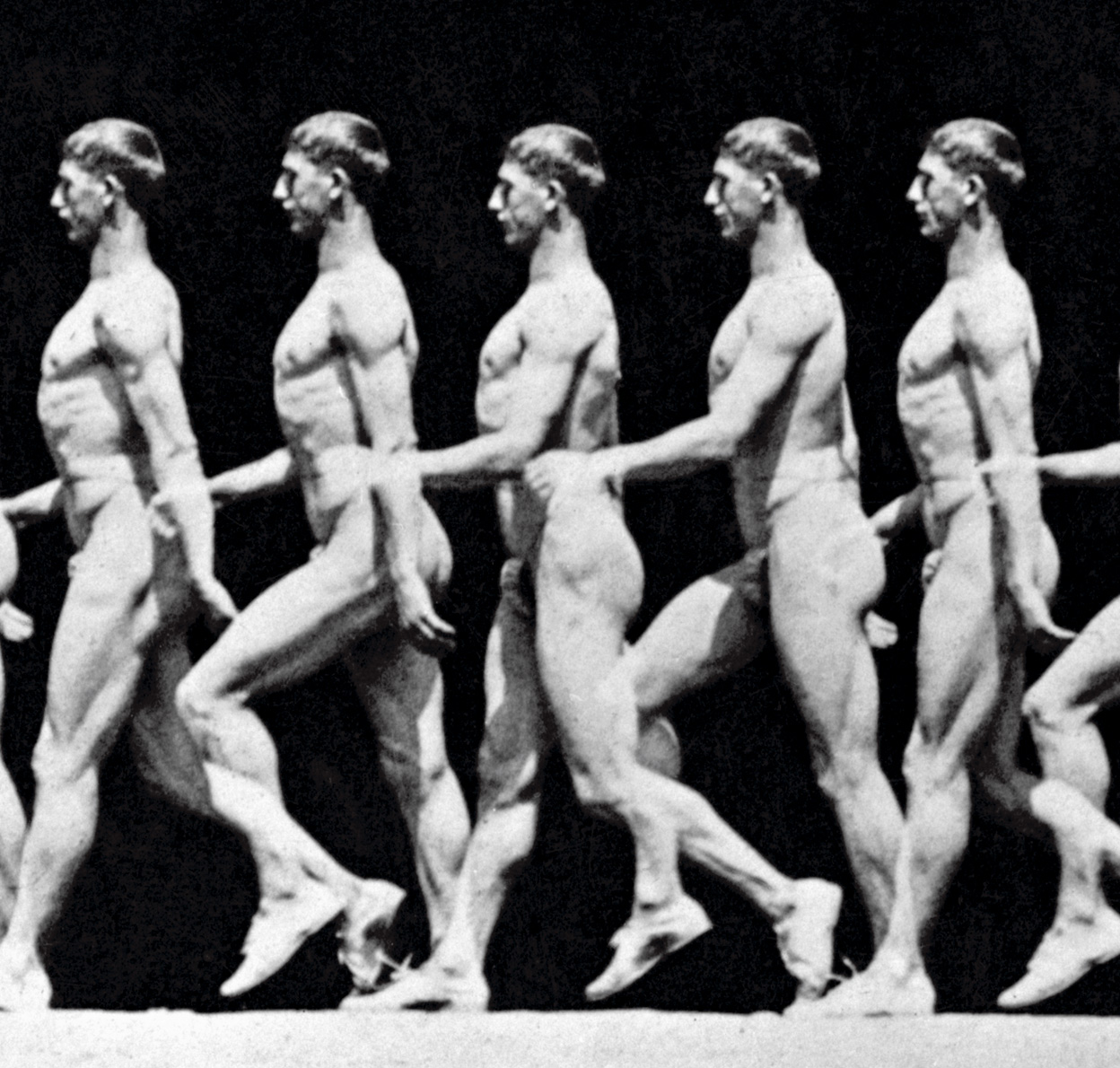
In her recent article in XL Semanal Raquel Peláez argued that “Caminar te va a salvar la vida” (Walking is going to save your life).
“Several scientific studies have shown that the physical and mental benefits of walking are immediate,” she wrote. “Never mind achieving 10,000 steps a day, every minute spent walking counts.”
This all stems from the fact that our species is unique in that we are upright animals, bi-peds. This allowed human beings to use their fore-legs, ie arms, for other purposes, such as carrying things, making things, using their hands. But on top of this it enabled us to put one foot in front of the other, to walk, which is the most easily achievable movement at our disposal.
Photo courtesy of XL Semanal
Prolong your life
According to scientists, people who walk live longer, have better balance, are happier and more intelligent. Several scientifioc studies have shown that there is no other form of exercise that has such a positive, strengthening and healthy effect on both body and mind as walking.
According to the latest study, carried out by researchers at North Western University in Illinois, USA, and published in the summer of 2023, in people over 40, modest physical activity is the most significant factor influencing health and longevity. Walking, together with a healthy diet and sufficient sleep, can reduce the chance of a premature death by 30 per cent in this age group.
The Unidad de Investigación de Atención Primaria at the University of Bizcaya in Bilbao has found that a small increase in physical exercise, eg fast walking for 50 minutes a week (less than eight minutes a day) reduces by 31 per cent the risk of a premature death amongst people who have led a sedentary life for decades .
On top of that, th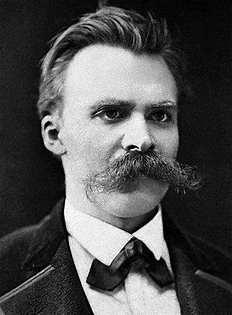 e number of steps per day required to start to notice a difference in one’s health, is far fewer than the mythical 10,000 steps. According to scientists at John Hopkins University in Maryland, USA, 4,000 steps are sufficient to start to reduce the risk of premature death. Indeed, this study indicates that 2,300 steps are sufficient to benefit the heart and blood vessels. e number of steps per day required to start to notice a difference in one’s health, is far fewer than the mythical 10,000 steps. According to scientists at John Hopkins University in Maryland, USA, 4,000 steps are sufficient to start to reduce the risk of premature death. Indeed, this study indicates that 2,300 steps are sufficient to benefit the heart and blood vessels.
During walking the body produces two neurotransmitters, endorphins and dopamine, the happiness hormone and the creative hormone respectively, which combat stress, prevent depression, and regularize sleep patterns. A study by Stanford University (California, USA) supports this argument by their discovery that walking increases creativity in a person by an average of 60 per cent.
As the German philosopher, Friedrich Nietzsche wrote: “A sedentary lifestyle is the real sin against the human spirit.”
Photo of Friedrich Nietzsche courtesy of Wikipedia
Benefits of walking

After 10 seconds - with every step the deep musculature in the body is activated and has a beneficial effect on the vertebrae and disks in the back.
After 5 minutes - even a short daily walk has a positive effect on our life expectancy.
After 11 minutes - you have burned 50 kilocalories, so in a week 350. According to a report by Cambridge University (UK), walking 11 minutes a day can help reduce cardiac disease, cerebro-vascular accidents, and certain types of cancer.
Photo courtesy of Henry Ford Health
After 12 minutes - exposure to 12 minutes of sunshine brings sufficient Vitamin D, vital for the metabolism, absorbing calcium and phosphates in the gut and for healthy bones.
After 20 minutes - great for reducing stress, relaxing muscles and the nervous system, and lowering blood pressure. It also helps us sleep better.
After 30 minutes - walking for half an hour per day for five days a week reduces the risk of heart disease by 19 per cent. The body starts to secrete serotonin, the happiness hormone. According to cardiologists we should walk for 30-40 minutes every day, preferably in the early evening, when our walk can improve our physical capacity, our metabolism and our blood pressure.
After 45 minutes - leading a more active life helps prevent colds. The University of South Carolina (USA) found that after a year of physical activity the average number of colds suffered by previously sedentary people fell by 23 per cent.
After 60 minutes - an hour's walk a day reduces the risk of suffering depression, according to a study by the University of South Australia which lasted 11 years and with 34,000 participants. A Japanese study concluded that a walk in the countryside is preferable to one in the town.
Acknowledgements:
Raquel Peláez
XL Semanal
Tags:
10,000 steps a day, Cambridge University, Crazy Guy, dopaminbe, endorphin, Friedrich Nietzsche, John Hopkins University, North Western University in Illinois, Raquel Peláez, Stanford University, Unidad de Investigación de Atención Primaria, University of Bizcaya, University of South Australia, University of South Carolina, Vitamin D, Wikipedia, XL Semanal,
 1
Like
Published at 10:45 AM Comments (0)
1
Like
Published at 10:45 AM Comments (0)
All you needed to know about The Crazy Guy.
Thursday, January 4, 2024
By The Crazy Guy
The Crazy Guy has two blogs on Eye On Spain, one eponymous and the other about "How to ....." do various things here in Spain.
The Crazy Guy is an alias for Paul Whitelock, which is no real secret.
Paul has several other noms de plume on Eye On Spain, depending on the theme of the blog.
THE CRAZY GUY

The Crazy Guy is known amongst the Spanish people where he lives as "El Loco", largely because, despite his advanced age, he's always active, doing this and that. So, he's "The Crazy Guy".
This blog is about some of the things he's been getting up to lately.
The Crazy Guy (El Loco, according to his fellow villagers) likes to keep busy. He hopes readers of this blog find his experiences interesting.
He has another blog on EOS called "How to .....?" which offers advice on how to do things here in Spain, based on his experiences.
HOW TO ..... ?
 This blog is intended to be helpful to English-speaking foreign residents in Spain by explaining "how to ... " do certain things. This blog is intended to be helpful to English-speaking foreign residents in Spain by explaining "how to ... " do certain things.
The Crazy Guy has lived in Spain full time since 2008. A fluent Spanish-speaker he reckons he knows his way round the bureaucracy, the indifference and sometimes downright rudeness of "funcionarios".
The Crazy Guy is known amongst the Spanish where he lives as "El Loco", largely because, despite his advanced age, he's always on the go, doing this and that. The Crazy Guy hopes his "How to ..." articles will be helpful to others.
ONLY JOE KING
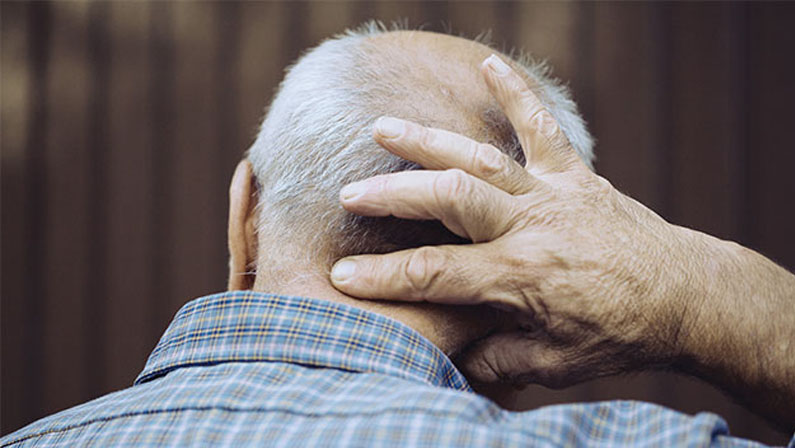
A light-hearted look at life in Andalucía and Spain in general; its good points and its bad. This blog doesn't pull any punches.
Only Joe King didn't really want anybody to know anything about him. That's just gone out of the window, BTW.
He's blogging because he thinks he has valid things to say. He hopes readers appreciate the pun in the name (Only joking!).
MY COVID-19 DIARY - MARCH 2020 TO DATE
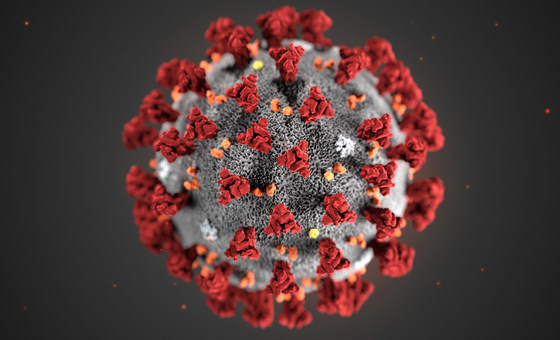 The coronavirus pandemic has hit the world hard, with over 120 million global victims. The coronavirus pandemic has hit the world hard, with over 120 million global victims.
I am British, married to a German and we live in Andalucía in the Serranía de Ronda.
This blog contains articles i've written since we both caught Covid-19 at the beginning of 2020. It was a weird life of curfews, lockdowns, masks, hand gel, rules and regulations and, for those of us who were affected directly, the vicious after-effects of the virus, long-covid, bereavement and financial ruin.
I started this blog in the aftermath of our personal experiences with the Coronavirus. Hopefully it has run its course, ie both Covid and this blog.
SPANISH MATTERS - A BLOG IN ENGLISH AND SPANISH FOR THOSE LEARNING THE LANGUAGE
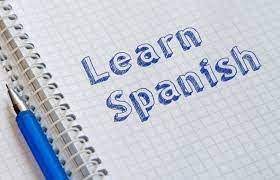
This blog is entitled "Spanish Matters", because it does!
Matter, that is.
If you have committed to living in Spain, in my opinion you should also make a commitment to learn some Spanish. Your life will be enhanced.
So this is a blog about matters Spanish, as well as promoting the notion that Spanish does indeed matter.
The blog contains articles in both English and Spanish. I hope it will be helpful to those learning the language.
The name Don Pablo betrays my origins as a former Spanish (and German) teacher in the UK.
This blog will continue to be added to from time to time.
PUNTOS DE VISTA - A PERSONAL SPAIN BLOG

Musings about Spain and Spanish life by Paul Whitelock, hispanophile of some 45 years and resident of Ronda in Andalucia for the last 15 years.
This is my main blog, indicated by the number of posts I have made, already well in excess of 100.
SERRANÍA KITCHEN - RECIPES FROM AROUND THE WORLD

This blog contains a selection of recipes from all over, in particular from Andalucía, Asia, England, Germany and the wider Mediterranean area.
Contributors include Rita Drechsler, Jovan Le Knorz, Madita Schröder, Carolyn Emmett, Simon Whitelock, Julie Wilkinson and Paul Whitelock, who are mostly members of the same extended Anglo-German family.
Rita and Paul, Carolyn, and Julie all live in the Serranía de Ronda in Andalucía.
Madita and Jovan live in Baden-Württemberg, near Heilbronn, Germany.
Simon lives near Bristol, in the UK.
THE CULTURE VULTURE
A blog 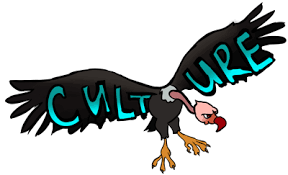 about cultural things: art, music, dance, literature, film and theatre. about cultural things: art, music, dance, literature, film and theatre.
The Culture Vulture enjoys the good things in life. These include art, music, dance, film, theatre, and books.
THE CURMUDGEON
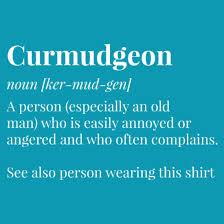
The Curmudgeon is a miserable sod. He likes to have a moan. He tackles subjects which many foreigners living in Spain agree with but are too polite to say anything about.
The Curmudgeon is now in his early 70s now and has lived in the Serrania de Ronda since he was 58.
THE HISTORY MAN
This blog co ntains interesting facts about the history of Spain and things Spanish. ntains interesting facts about the history of Spain and things Spanish.
The History Man discovered Spain some 50-odd years ago and he fell in love with the place. He has been resident here for 15 years and takes a keen interest in all things historical, geographical and cultural.
He is blogging because he hopes readers will find what he writes interesting.
THE SPANISH FLY - TRAVELS IN SPAIN AND BEYOND
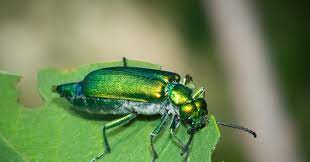
The Spanish Fly is a nom de plume of Paul Whitelock who first visited Spain at the age of 20. Now more than 50 years later, he has been to most parts of the country, including nine of the 12 islands. He has owned property in Andalucía since 2001 and has lived in the region for the last 15 years. This blog is a travelogue about some of the places he has visited.
The Spanish Fly writes keenly about his travel experiences in Spain and beyond. He hopes you enjoy sharing his journeys and are inspired to make similar ones yourself.
***
EPILOGUE
So, now you know. All of these blogs are written by li'l ol' me, Paul Whitelock.
I hope you enjoy reading them. Please feel free to comment.
© Paul Whitelock
Tags: Andalucia, blog, blogger, Coronavirus, Covid-19, Crazy Guy, Culture Vulture, Curmudgeon, Don Pablo, El Loco, EOS, Eye on Spain, History Man, How to .....?, Joe King, noms de plume, Only Joe King, Paul Whitelock, Puntos de Vista, Serrania Kitchen, Spanish Fly, Spanish Matters
 0
Like
Published at 12:27 AM Comments (0)
0
Like
Published at 12:27 AM Comments (0)
The Houses That Jack Built - update
Thursday, October 5, 2023
By The Crazy Guy
The Crazy Guy, known by the Spanish locals as "El Loco", was a languages teacher, a school inspector and a translator and interpreter. Since retirement over 18 years ago he has also dabbled in journalism and blogging.
 But what he really wanted to do when he was younger was to be a tradesman, eg. plumber, electrician, carpenter, bricklayer, tiler or painter and decorator. Over the years he’s had a go at all of these on an amateur, DIY basis with relative success. But what he really wanted to do when he was younger was to be a tradesman, eg. plumber, electrician, carpenter, bricklayer, tiler or painter and decorator. Over the years he’s had a go at all of these on an amateur, DIY basis with relative success.
Here’s the story of the houses that Jack – The Crazy Guy - built! Or helped to build…..
Photo courtesy of Karl Smallman
First steps
I first started doing bits and pieces of DIY when I was a poorly paid young teacher. My wife Jeryl and I bought our first house, a semi-detached in Walkden, Greater Manchester, for £11,000. A lot of money back then and the mortgage interest rate was around 16 per cent!
Unable to afford to employ professionals, I informed myself from books (no YouTube videos back then in the late 1970s) and tentatively did a bit of electrical work, plumbing and painting and decorating, aided and abetted by Jeryl. We were childless then, so no distractions.
After about three years we sold up and moved to our second house, in Thelwall, Warrington, not far from the infamous Thelwall Viaduct on the M6. A three-bed detached it cost us just £37,500, a huge amount in 1980.
Over the next 20 years, the house grew in size to become a four-bedroomed, two bath-roomed house with four reception rooms and a third WC, plus a garage and a large balcony overlooking the adjacent park.
Although builders did the main construction work, my DIY skills had developed so much that I was able to re-wire the whole house, convert the original garage into an extra lounge-cum-music room, turn the separate toilet and bathroom into an ensuite bathroom with new suite, install a shower, replace all the guttering and drainpipes and build two patios and a pergola. Not to mention wall-papering and painting throughout. I even built a tree house for my two kids.
Houses in Spain, Wales and Luxembourg
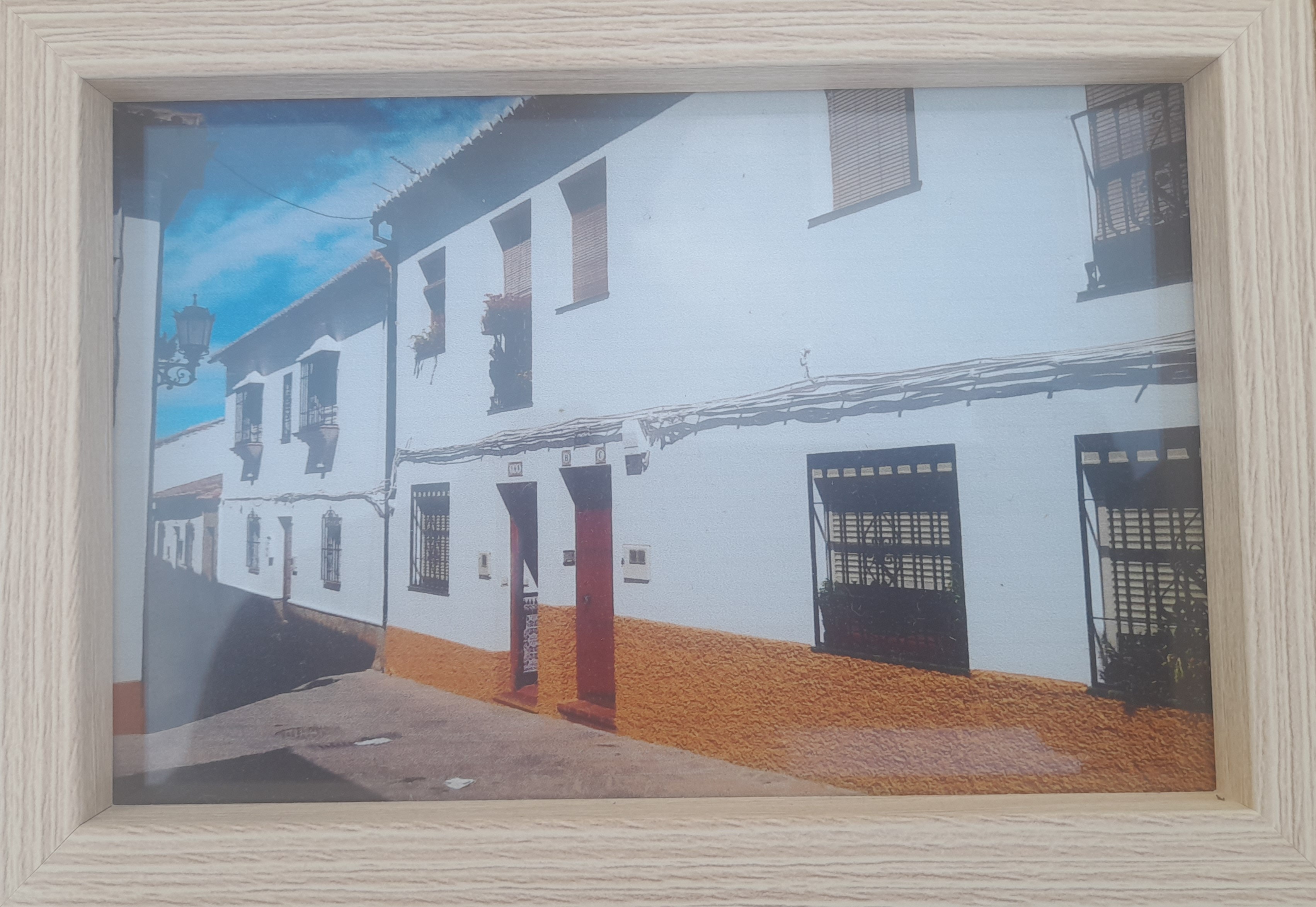 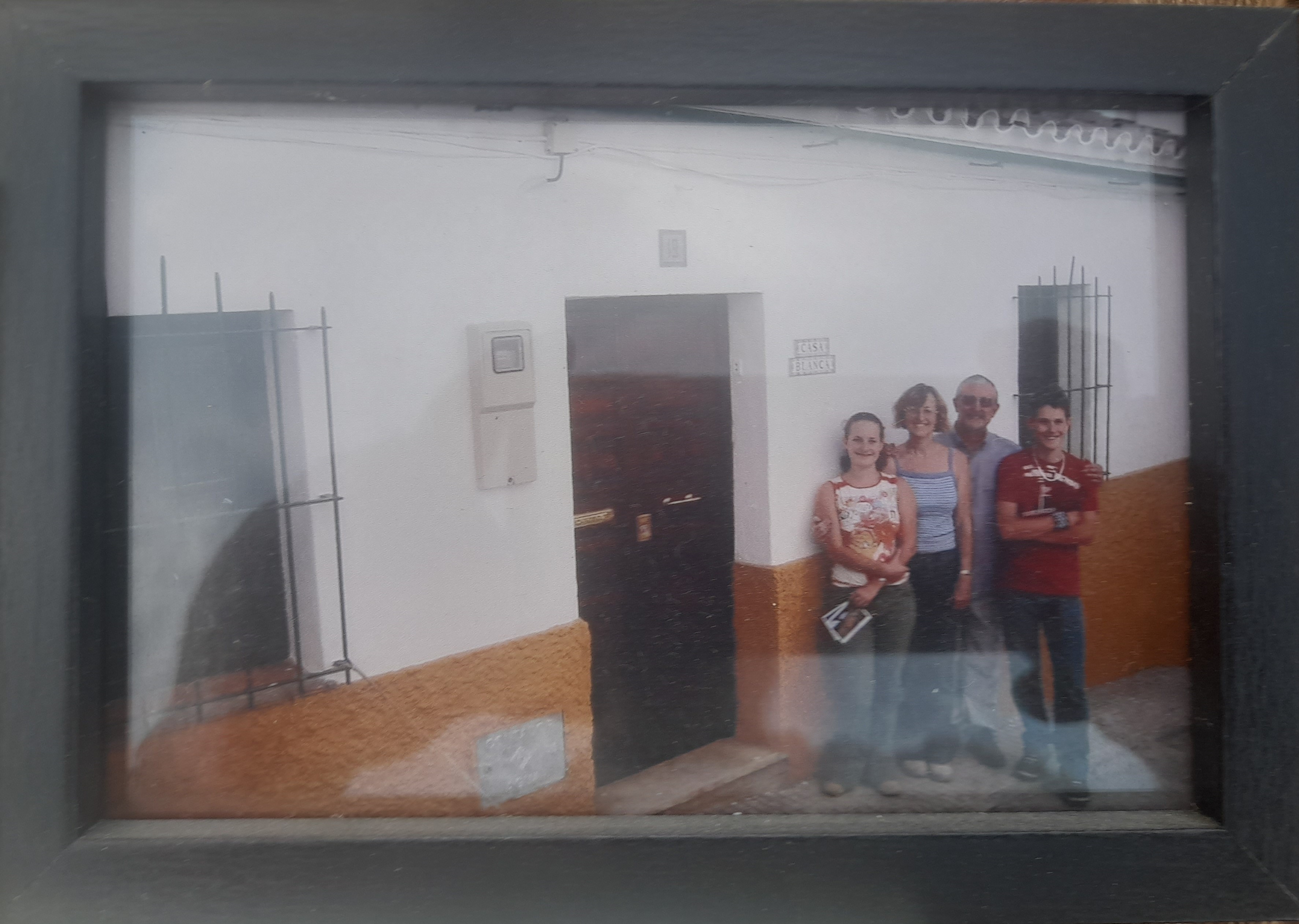 In the early 2000s Jeryl and I bought two properties in relatively quick succession in Ronda, Andalucia. The first, Piso Blanco, was a small flat that needed little doing to it, but the second, an end-terraced house, which we named Casa Blanca, was virtually a ruin. In the early 2000s Jeryl and I bought two properties in relatively quick succession in Ronda, Andalucia. The first, Piso Blanco, was a small flat that needed little doing to it, but the second, an end-terraced house, which we named Casa Blanca, was virtually a ruin.
Over the next couple of years, I re-wired it, replaced a collapsed floor, upgraded the kitchen, re-built the terrace and decorated throughout.
Then disaster struck, or should I say three disasters!
Redundancy, early retirement and divorce in quick succession, in 2005, saw me living with a new lady, Maude, a wido, in her beautiful cottage in Bryn-y-Maen, North Wales.
I did a few bits and pieces there to keep my hand in and then, when I took her to Ronda for a long weekend, Maude bought a small house there on the spur of the moment.
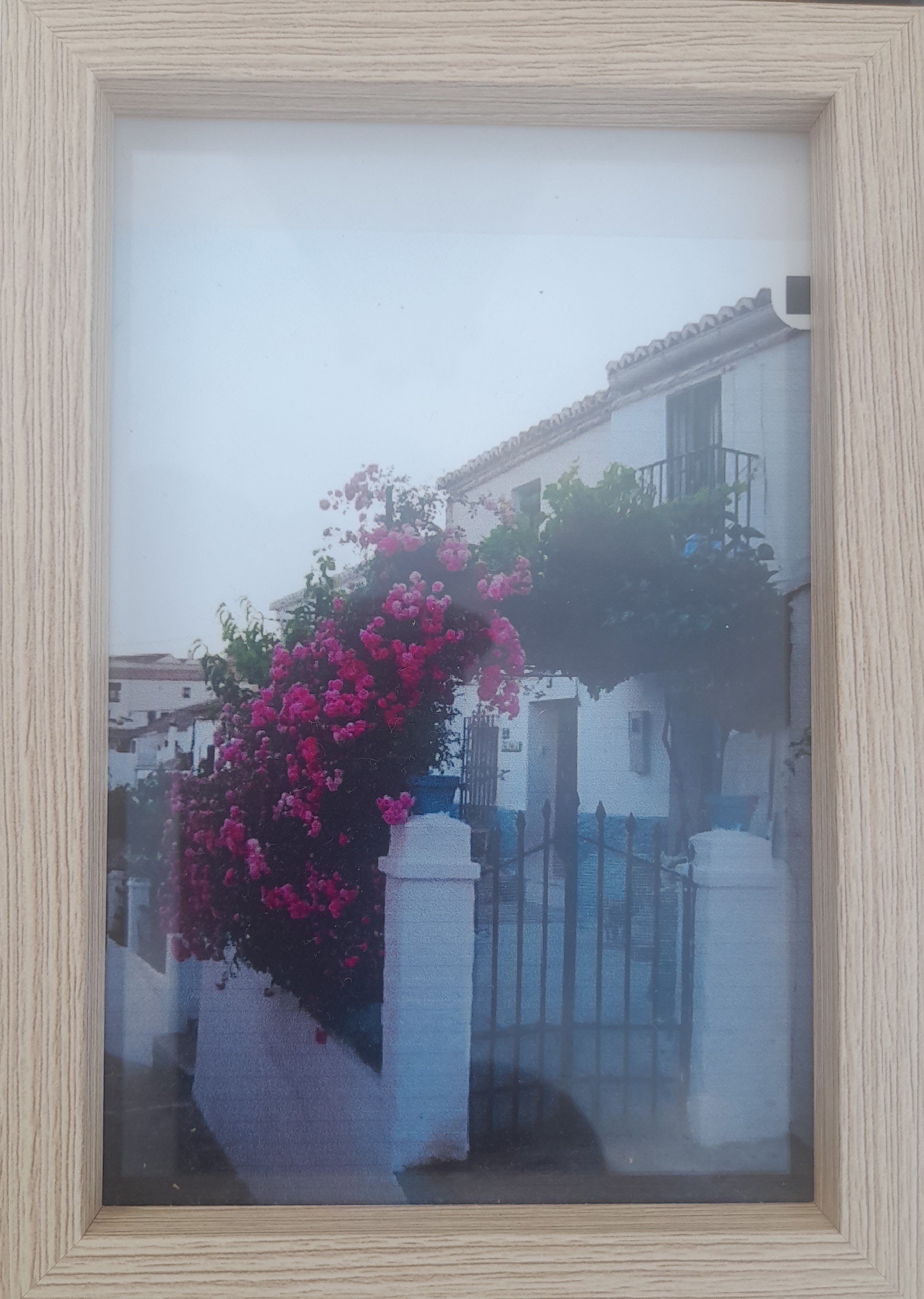 We called it El Rincón because it was tucked away in a corner. It needed a lot of work, which I happily took on. Maude was still working full time in the UK, but I was retired so spent months in Ronda re-wiring, building a new bathroom, tiling floors and creating a rather delightful, terraced garden at the rear of the house. A good lick of paint and El Rincón was finished. We called it El Rincón because it was tucked away in a corner. It needed a lot of work, which I happily took on. Maude was still working full time in the UK, but I was retired so spent months in Ronda re-wiring, building a new bathroom, tiling floors and creating a rather delightful, terraced garden at the rear of the house. A good lick of paint and El Rincón was finished.
The end of the relationship with Maude put paid to my DIY activities for a couple of years, until an old university friend, Jac, who lives in Luxembourg, invited me to spend the summer of 2008 in the Grand Duchy helping her daughter and son-in-law renovate an old house they’d bought there.
That was great fun and I developed some new skills, as building practices there differ significantly from the ones I had become familiar with in the UK.
Back to Warrington
After that busy but enjoyable summer of 2008 I was foot-loose and fancy-free again, so headed off to Ronda to stay in Piso Blanco for a few days, prior to moving into a house in Latchford, Warrington, which I’d bought with the proceeds from the sale of Casa Blanca, the Ronda house I’d done up a few years before.
The Warrington house was a real bargain. Tunstall Villa, as the “new” house in Latchford was named, was a “do-er up-er”. A Victorian detached villa, rather down on its luck, it had the potential to be a great house again. It only cost me £119,000.
Still “unemployed” - by this time I’d been retired for three years - I had plenty of time on my hands, so I set about the renovation. Over many months I created a delightful winter garden, renovated the rear internal area to provide a WC and laundry room, re-decorated throughout, and then, after two and a half years ….. I sold it!
Why on earth …..?
Back to Andalucia
Well, on that visit to Ronda in September 2008 that I mentioned earlier, I’d met a lady I nicknamed the “Meter Maid”! Yes, you guessed it, her name is Rita. We dated in Spain, the UK and Germany, where she is from, and quickly fell in love.
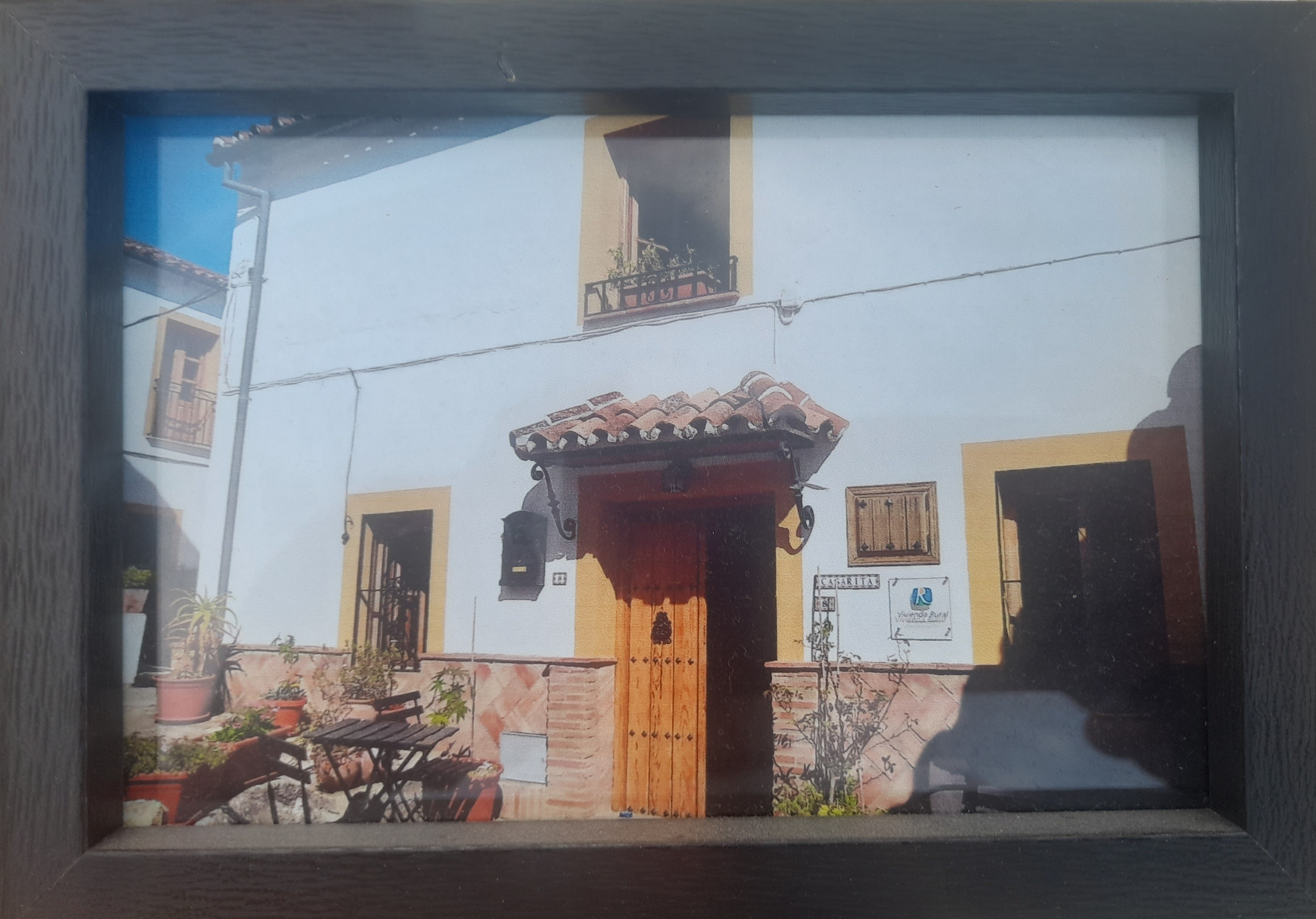 I immigrated to Spain at the end of that year to live with Rita in her lovely village house, Casa Rita, in Montejaque. In 2010 we married. I immigrated to Spain at the end of that year to live with Rita in her lovely village house, Casa Rita, in Montejaque. In 2010 we married.
The DIY didn’t stop, however! I built a kitchenette in a bedroom in Casa Rita, that we set up as a B & B, and handled all the maintenance work there.
Both having committed to living in Spain, we needed a house that better met the needs of our respective families, eg her disabled grandson, my ailing mother. So, I sold Tunstall Villa in Latchford and we used the money from the sale to buy our dream house in the campo just outside Ronda.
.jpg) That house is known as Villa Indiana. That all happened in 2011, the year after we “jumped the broom” and we still live there after 13 years of married life. That house is known as Villa Indiana. That all happened in 2011, the year after we “jumped the broom” and we still live there after 13 years of married life.
The DIY and gardening have continued, of course, although, as I get older, I rely a bit more on local tradesmen to keep on top of things.
In 2019 I decided to sell Piso Blanco in Ronda after 18 years’ ownership. We had been using it as a holiday rental, but all of a sudden the bookings started to dry up, so it had to go.
In October 2020, I used some of the money from that sale to buy a charming old house in Montejaque, where we had previously lived. I needed a project again and so I am currently restoring it to its former glory.
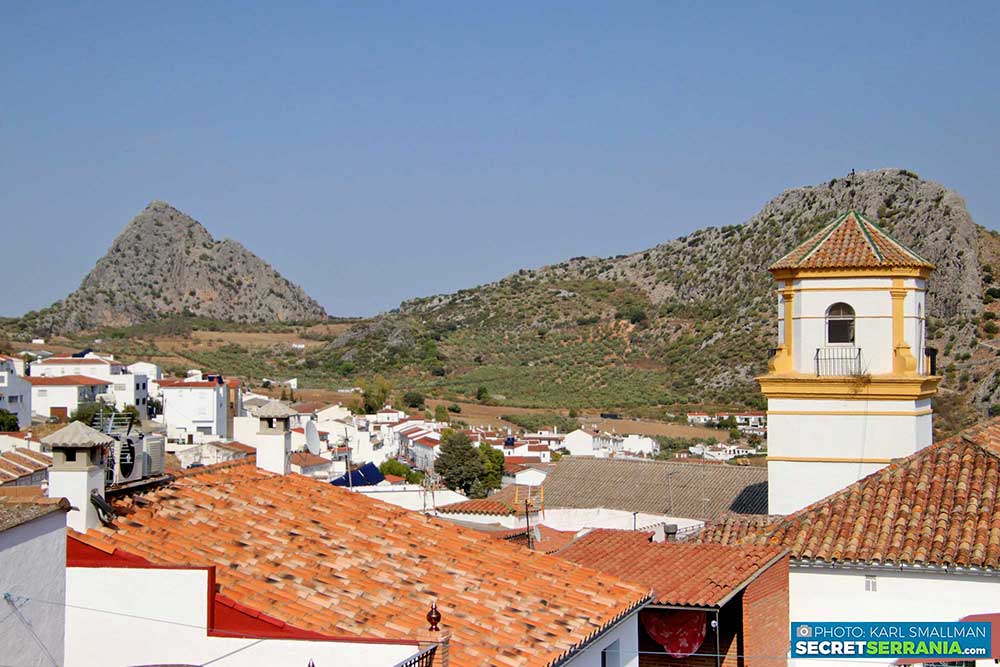 To be sure, I’m 73 now but the mind is still willing even if the flesh is weak. With the help of professionals, Casa Real is currently being re-configured and re-wired, prior to re-plastering, installing a new bathroom and extending the roof terrace. Then it will have a lick of paint prior to being offered as a vivienda rural to tourists who, since the Covid-19 lockdowns, are travelling again. To be sure, I’m 73 now but the mind is still willing even if the flesh is weak. With the help of professionals, Casa Real is currently being re-configured and re-wired, prior to re-plastering, installing a new bathroom and extending the roof terrace. Then it will have a lick of paint prior to being offered as a vivienda rural to tourists who, since the Covid-19 lockdowns, are travelling again.
This winter I am targeting the growing market for digital nomads. I’ve created two fully equipped workspaces for people who fancy working remotely. It’s a burgeoning trend. The Spanish government has even created a special visa and offered tax breaks to encourage more of these remote workers to choose Spain.
At my age maybe I should just hang up my DIY boots! But then this happened …..
A Victorian Pile in Hastings
In 2021, my son Tom and his wife Su, both actors, decided they needed a better quality of life before they started a family. So, they moved from London to the Sussex coast, to Hastings, where Su is from.
So, in early 2022 I spent a week in Hastings helping Tom with the renovation of a large, neglected Victorian terraced house which the couple had bought. By this time they had a son, Wilbur.
In the house, the main job was to replumb the place and strip out the century-old lead pipework, but we also did a lot of drylining of walls ready for plastering and I made a garden gate out of a recycled pallet.
Then Tom and Su had their second child, Buckley, a brother for Wilbur, so the building work needed to be put on hold.
I’m currently waiting for the call to go and help with painting and decorating and the installation of a new bathroom.
Watch this space!
© The Crazy Guy
Further reading:
The Building History of a 72-year-old DIY Fan (eyeonspain.com)
CASA MONTEJAQUE (a1-holidays.net)
Casa Rita Holiday Rental Montejaque - Secret Serrania de Ronda
DIGITAL NOMADS - Help me, Ronda (help-me-ronda.com)
Photographs:
Karl Smallman, www.secretserrania.com
Paul Whitelock, www.help-me-ronda.com
Note: This article is an adaptation and an updating of an original article written in 2000.
Tags: Casa Blanca, Casa Montejaque, Casa Real, Casa Rita, Crazy Guy, digital nomads, DIY, El Loco, Hastings, Latchford, Luxembourg, Piso Blanco Rincon, Ronda, Thelwall, Tunstall Villa, Victorian pile, Villa Indiana, Walkden, Warrington
 1
Like
Published at 9:37 AM Comments (0)
1
Like
Published at 9:37 AM Comments (0)
ONCE Upon a Time
Tuesday, February 7, 2023
By The Crazy Guy
I buy ONCE a week.
A lottery ticket that is. I usually buy it off the man in green and yellow who calls at Bar Encuentro in Benaoján, or from the cuponera in green and yellow in the green and yellow ONCE kiosk outside the bus station in Ronda.
ONCE is of course the Organiza ción Nacional de Ciegos Españoles, the National Blind Society. They have had a licence to run a lottery to raise funds since their formation. ción Nacional de Ciegos Españoles, the National Blind Society. They have had a licence to run a lottery to raise funds since their formation.
Established in 1938, ONCE’s raison d’être is to provide support for sight-challenged people, in the form of training and employment. Currently, 83% of its workforce is blind or partially sighted.
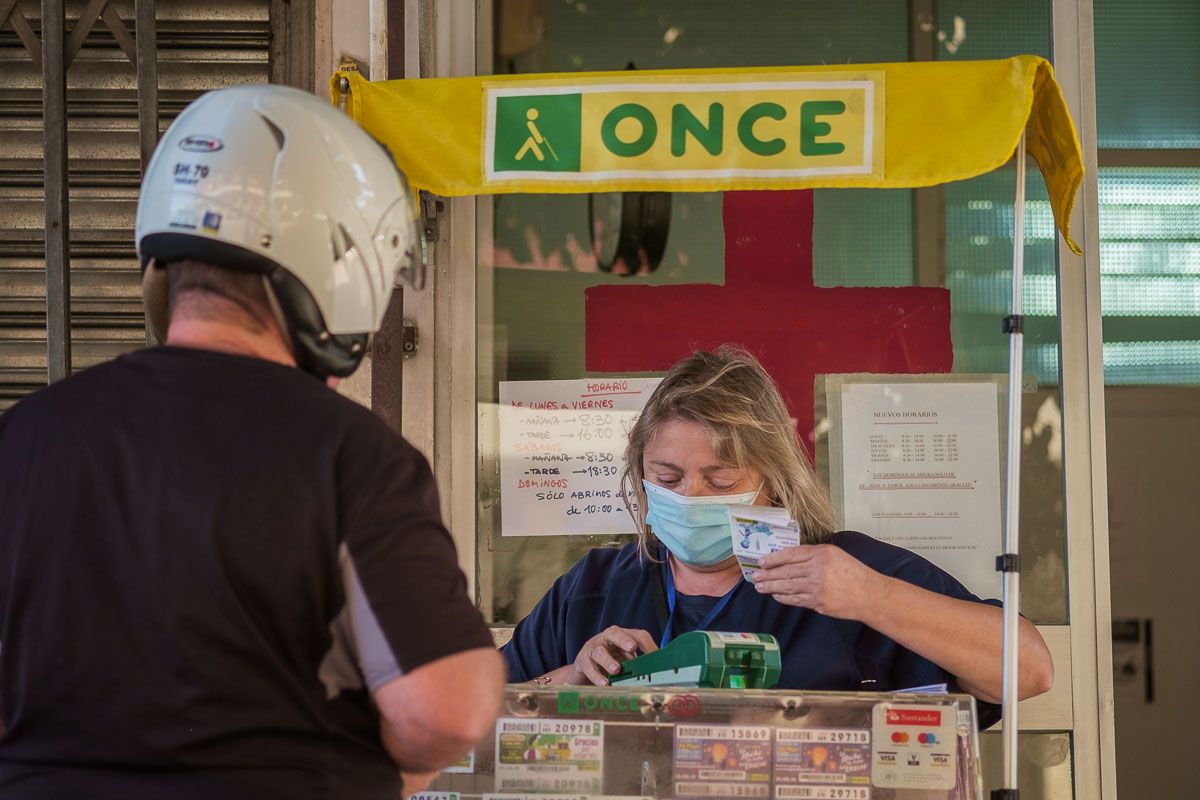 The lottery offers a range of different products. There is a daily lottery, El Diario (1.50€), Euromillions on Tuesdays and Thursdays (2€), El Cuponazo on Fridays (3€), special lotteries (Loterias Especiales) and various types of scratch cards (Rascas). The special currently is for Día del Padre and costs 5€. The lottery offers a range of different products. There is a daily lottery, El Diario (1.50€), Euromillions on Tuesdays and Thursdays (2€), El Cuponazo on Fridays (3€), special lotteries (Loterias Especiales) and various types of scratch cards (Rascas). The special currently is for Día del Padre and costs 5€.
I’ve had several wins on El Cuponazo, but only 3€ each time. I just re-invest my winnings on the next Cuponazo.
Just ONCE, I hope to win a sizeable sum. Pigs might fly, of course!
© The Crazy Guy
Acknowledgement:
www.once.es
Tags: ciego, Cuponazo, cuponera, Joe King, loteria, lottery, ONCE,
 0
Like
Published at 9:07 AM Comments (0)
0
Like
Published at 9:07 AM Comments (0)
The Building History of a 72-year-old DIY Fan
Thursday, January 5, 2023
A 72 –year-old British man has just completed the total reforma of a village house in the tiny pueblo blanco of Montejaque (Málaga).
Known as The Crazy Guy, the former languages teacher, school inspector and translator, has been a resident of Montejaque and Ronda since 2008.
But his relationship with the northern part of the Serranía de Ronda began eight years earlier, in 2000, when the Devonian visited Ronda for the first time with his then wife, Jeryl.
Silver wedding tour
We came to Andalucía to celebrate our silver wedding anniversary and over the course of a week did a circular tour which incorporated Ronda, Arcos de la Frontera, Jerez, Cádiz, Sevilla, Granada, Córdoba, Antequera and Málaga.
All beautiful places in their different ways, but the place we liked the most was Ronda, so we decided to buy ourselves a "bolt-hole" in the area.
Piso Blanco and Casa Blanca
After viewing umpteen properties over the following 18 months, we bought an apartment in the town in December 2001. We called it Piso Blanco, because it was (ie white) and reflected a part of our surname.
In 2003 we bought an abandoned house just 50 metres from Piso Blanco, which we christened Casa Blanca (of course!).
I had learned many DIY skills from my dad, and I had already carried out some major work on our house near Warrington (eg re-wiring, creating an en-suite bathroom, converting a garage into a music room/second lounge and even building a tree house for my two children).
With great enthusiasm I took on the task of converting this run-down house in Ronda into something liveable.
Over the course of two years, with the help of my family, Jeryl, Amy and Tom, and friends Alan and Johnny, we created the new, improved Casa Blanca in the Barrio San Francisco.
Life changes
A period of turbulence in my life – redundancy, nervous breakdown and divorce all in the same year, 2005, coincided with me renovating a second house in Ronda which belonged to my girlfriend of the time, Maude.
The house was located in the Las Peñas district near the town centre and was named El Rincón, because it was tucked into a corner.
When my relationship with Maude ended, I returned to the UK and went to live with my mum in Thelwall near Warrington.
Luxembourg
Out of the blue an old friend from university contacted me to ask for help over the summer of 2008. How could I refuse?
Jac, a Welsh lady, had studied the same languages as I had at the same university, namely Spanish and German, and we were in every class/lecture together. I had fancied her back then, but my pal Dan was quicker off the mark and indeed the couple married while we were all still undergraduates.
After graduation Jac and Dan moved to Luxembourg to work for the European Commission as translators. They soon had two children and their lives seemed settled. However, Dan was experiencing mental health problems, went off the rails, started taking hard drugs and had several affairs. Sadly, he ended up taking his own life.
Jac decided to stay on in Luxembourg, despite being a young widow with two small children. She left the Commission and developed a new career as a piano teacher.
Fast forward to 2008. Jac had just bought an old house for her daughter Miriam and husband and needed my help to get it into shape.
The deal was that Jac would pay for my flight and give me board and lodging in exchange for my labour. Sounded good to me!
With my mum’s blessing off I flew to Luxembourg for the summer. The renovation project was fun and I was surprised at how much I was able to contribute at the ripe old age of 58!
It turned out to be a great summer. Jac and I even had a short romance, but there was to be no future in it, sadly from my point of view, as 40 years on from our student days I still fancied the girl from the Welsh valleys.
Disappointed, I did not go back to the UK with my tail between my legs. Instead I flew to Spain to spend a long weekend in Ronda.
"Coup de foudre" in Ronda and Montejaque
Little did I know that I was destined to meet the lovely Rita …..
In the meantime, retired and single, I had decided it was time to stop living with my mum and should buy myself somewhere to live in the UK.
I sold Casa Blanca in Ronda and bought Tunstall Villa, a run-down Victorian villa in Latchford, Warrington. This “reform” was to be my project for the next couple of years. Three years later I sold it to buy a home for me and Rita in the Ronda area. We had married the year before, in 2010.
Back to the present, married to Rita for 12 years and a Spanish resident for 14, and after a significant gap in terms of DIY, I sold Piso Blanco and used some of the proceeds to buy an old house in Montejaque. I needed another building project.
From August 2020 until August 2021, with four months working time lost to Covid-19 lockdowns, I worked with friends Jorge, José, Stewart, Miriam Leti and Kiko on renovating the house which is now an exciting mix of traditional and modern.
I originally named the house Casa Real, in honour of the family that owned the house for three generations. Their surname is Real. However, that name doesn’t work for SEO purposes, because it also means “royal house”, so I’ve changed the name to Casa Montejaque.
In between times, I spent a week in Hastings in February 2022 helping my son Tom to renovate a large Victorian terraced-house he and wife Su had bought as a project (chip off the old block or what?!).
Amongst many two-person jobs we completed, we replaced the old lead plumbing with copper piping, and dry-lined several walls ready for plastering.
I’ll probably be going over again soon to install a new bathroom.
Note: Casa Montejaque is now available to rent as a vivienda rural. You can contact The Crazy Guy via the Comments section of Eye on Spain.
© The Crazy Guy
Tags: Antequera, Arcos de la Frontera, Cádiz, Córdoba, Covid-19, Crazy Guy, Casa Blanca, Casa Montejaque, Casa Real, DIY, El Rincon, Granada, Hastings, Jac, Jerez, Jeryl, Jorge, José, Kiko, Las Penas, Leti, London, Luxembourg, Málaga, Maude, Miriam, Montejaque, Piso Blanco, property developer, Ronda, Sevilla, Stewart, Su, Tom, Tunstall Villa, Victorian terraced-house
 0
Like
Published at 8:45 AM Comments (1)
0
Like
Published at 8:45 AM Comments (1)
Wrong way round?
Monday, January 2, 2023
The Crazy Guy retired at 55, divorced at 56, emigrated to Spain at 58, got married again at 60, bought a house in the UK at 61, sold a flat in Ronda (Málaga) at 68, and became a property tycoon aged 70!
Is he a very late developer or what? And why has he been so busy in the last few years?
Am I a late developer? Not really, life just happened that way. Nervous breakdown, marriage break-up and redundancy all in the same year, 2004, is a pretty hefty triple whammy in anyone’s book. So a lot of adjustments had to be made.
Why am I so busy? Because the Covid-19 pandemic made me take stock of my life (and death). Surrounded by the latter, random passings from the deadly Coronavirus, a family death in a plane crash in Australia, the near death of my wife in 2021 at the hands of “el bicho”, as the Spanish somewhat dismissively call the Covid-19 virus, and my own long-Covid issues, I decided I needed to make the most of whatever time I’ve got left.
So, at the moment, yes, I am very busy. I continue to write for EyeOnSpain and other websites. I am still helping to bring my wife back to full strength, whilst coping with my own health issues. I’ve been doing up a house, created an allotment and I landed myself a job at the age of 71, although that didn’t last very long.
The Crazy guy
The young folk of Montejaque, the pueblo blanco where I live, near Ronda, don’t get it. Why is a retired bloke working all the hours God sends, including Sundays? Is he crazy or what? All they’re looking forward to is the day they retire ….. and they’re only in their 20s! They’ll have a long wait, I’m afraid.
I say to them, that if they ever get to retire (the retirement age keeps going up – so some of them will surely die before they reach it!) they’ll need to be active too, in order to avoid the crushing boredom of retirement with nothing to do. They think I’m crazy, sure, but I’m older and wiser – they’ll learn!
Prioritising
So, I thought I’d cut back on the writing, but that hasn’t happened. I find it therapeutic.
My lovely wife (the “Lovely Rita” – Beatles?) is getting better by the day, and I’m learning to live with my breathing issues. Covid got to my lungs and it won’t let go, so I just take longer to walk anywhere. We’d planned to do the Caminito del Rey in 2022, but I’ve had to pass on that.
Casa Montejaque has come along nicely and phases 1 and 2 of the renovation are complete and phase 3 is drawing to a conclusion. If it hadn’t been for the four months working time lost because of the two local Covid-19 lockdowns, and recent heavy rain, it would be ready. It goes back on the holiday rental market at the end of January 2023, when I hope to start picking up bookings for Spring and Summer.
Travelling
Since Covid we’ve been travelling more. Frigiliana, Extremadura, Madrid, Toledo, Germany, Cornwall, Germany again, Nerja, Malaga, Sevilla, London, Jerez de la Frontera, Germany yet again.
In 2023, we’ve got Hastings (England), France, Cordoba and Granada in our sights. Possibly Budapest.
Conclusion
So, yes, in many ways, I have kind of got my life the wrong way round.
Am I a late developer? Maybe.
Am I Busy? Yes, I am.
Am I crazy? Definitely!
© The Crazy Guy
Tags: bicho, Budapest, Cornwall, Cordoba, Coronavirus, Covid-19, Crazy Guy, Casa Blanca, Casa Montejaque, Casa Real, DIY, El Rincon, Extremadura, France, Frigiliana, Germany, Granada, Hastings, Jac, Jerez de la Frontera, Jeryl, London, Luxembourg, Madrid, Malaga, Maude, Montejaque, Nerja, Piso Blanco, property developer, Ronda, Sevilla, Toledo
 0
Like
Published at 8:12 AM Comments (0)
0
Like
Published at 8:12 AM Comments (0)
Montejaque Metamorphosis
Thursday, December 29, 2022
When The Crazy Guy bought an old Spanish house to do up in Montejaque (Málaga) in October 2020 he had a clear overall vision of what he wanted to create.
His aim was to turn the 19th Century village house into a vivienda rural, a holiday rental, as quickly and cheaply as possible.
That idea didn’t last long. He got to love the place so much he decided to up the spec and create "something special", a second home, rather than a basic, run-of-the-mill holiday let.
The vision
I quickly settled on a set of basic principles:
- Retain as much of the original fabric and decor as possible, eg original wall and floor tiles
- Use recycled, found objects and second-hand items as much as possible
- Turn it into an eco-house and make it as environmentally friendly as possible
- Do much of the work myself, in order to save money and because I enjoy DIY.
Rather than try to complete the whole project in one go, I decided on four distinct phases:
Phase 1
To get the house on the rental market as quickly as I could
- Complete electrical re-wire
- Complete re-plumb, ie remove original lead piping and replace with copper
- Remove two internal walls on the ground floor in order to create an L-shaped lounge, dining room and kitchen
- Install two new bathrooms, one on each floor
- Modernise the dated kitchen
- Refurbish two bedrooms on the first floor
- Fit banisters to stairs
- Install TV and Internet
- Decorate throughout
This went more or less to plan, yet took a year - much longer than I had planned.
Major hold-ups were caused by two Covid lockdowns, totalling four months, when we couldn’t work; and the need to demolish the kitchen ceiling/bathroom floor, as the wooden beams had rotted and it was unsafe.
Undeterred, we pressed on and the Casa Montejaque was ready to receive its first guests in October 2021. They were friends of ours, Hovis, Jacqui and Richard, and they agreed to "snag" the house, which was very helpful. They were very positive about their stay, yet made some constructive, and valid, suggestions.
My next guests, a German family of six, stayed for nearly two months in February/March of 2022. Dad Ollie, a time-served joiner, and I made a deal. He would do carpentry work on the house in lieu of rent. A win-win for all of us.
Meanwhile, Mum Lily was still breast-feeding the youngest child, Cailan, yet found time to join in the free Spanish classes in the village, while the three older girls, Leyla, Amy and Alice enrolled at the primary school.
After that amazing barter arrangement, phase 1 was finally finished and Casa Montejaque had a steady stream of guests throughout 2022, from Alicante, Sevilla, Ubrique, Denmark and the UK.
Phase 2
Extension of the roof terrace
Apart from providing more outside space, it would solve a leak problem above the main stairs.
Four of us worked on the construction for a month, and I spent another month completing the waterproofing, tiling and painting. Phase 2 is now complete, apart from a bit of tidying up, and the terrace is now three times as big as before. Job done!
Phase 3
Conversion of a former workshop and store into a third bedroom
This has been a major task. The existing roof was of corrugated iron sheets with clay tiles laid on top. So the room was hot in summer and cold in winter.
A friend helped me to install wooden beams with polystyrene insulation in between, which I subsequently finished off with bamboo. I must say it looks very traditional and rather nice.
The uneven wooden floorboards had to recovered and levelled, some extra power sockets installed and the whole room decorated.
Eco-house
In order to make CASA MONTEJAQUE as environmentally friendly as possible, I did the following:
- Used re-cycled items
- Up-cycled furniture
- Bought many items second hand
- Installed new double-glazed windows and front door
- Purchased new electrodomésticos, ie hob, oven, washing machine, iron, and vacuum cleaner, with low energy ratings
- Installed a new gas caldera for the hot water
- Installed a state-of-the-art pellet burner for heating
- Fitted solar lighting in external areas
Phase 4
Next on the list are photo-voltaic solar panels to provide all our electricity needs
This is pending until we’ve saved enough to pay for the work.
Digital nomads
The finished bedroom, to be called The Workshop, has two single beds, a built-in wardrobe, bookshelves and, la pièce de résistance, an office area to allow for remote working by renters and guests (digital nomads).
***
With just a few bits and pieces to finish off, CASA MONTEJAQUE will be ready to go as a "sleeps 7" by the end of January 2023.
You can view the results of my endeavours on my website. Please click on Interesting Links (right).
Should you wish to book, please do so directly via that link. It works out cheaper for you and for me.
Note:
Originally I christened the house CASA REAL in honour of the three generations of the family who were the previous, and only, owners of the house. Their surname is/was REAL.
However, I have been advised by experts that the name doesn’t work as regards SEO (search engine optimisation), so for marketing purposes I’ve changed the name to CASA MONTEJAQUE, which "does what it says on the tin".
© The Crazy Guy
Further reading:
Casa Real: A building project in Montejaque - Part I
Casa Real: A building project in Montejaque – Part II
Casa Real: A building project in Montejaque – Part III
Ollie and Lily
The houses that Jack built!
Tags: bathroom, building project, Casa Montejaque, Casa Real, DIY, eco-house, found, holiday rental, kitchen, Montejaque, photo-voltaic, recycling, re-plumb, re-wire, roof terrace, second-hand, secretserrania.com, SEO, solar panels, village house, vivienda rural
 0
Like
Published at 9:44 PM Comments (0)
0
Like
Published at 9:44 PM Comments (0)
Spam post or Abuse? Please let us know
|
|